Our verdict
- Top pick in best Nike running shoes
- Top pick in best marathon running shoes
Pros
- Remarkably lightweight despite its broad size
- Best-in-class breathability
- Excels in the marathon distance
- Repositioned Air Pods offer a better ride than the v2
- ZoomX foam delivers massive energy return
- Aids in forward momentum, especially when legs begin to fatigue
- Better than ever for 5K/10K racing
- Finally smooth transitions!
Cons
- Heel strikers might wear down the outsole quickly
- The arch could still be a challenge for some
- The sock-like tongue might not suit everyone
Audience verdict
- Top 30% in Nike running shoes
- Top 7% most popular running shoes
Comparison
The most similar running shoes compared
+ + Add a shoe | |||||
|---|---|---|---|---|---|
| Audience score | 88 Great! | 87 Great! | 90 Superb! | 88 Great! | |
| Price | £285 | £230 | £195 | £250 | |
| Pace | Competition | Competition | CompetitionTempo | CompetitionTempo | |
| Shock absorption | High | High | High | High | |
| Energy return | High | High | High | High | |
| Traction | Moderate | High | High | High | |
| Arch support | Neutral | Neutral | Neutral | Neutral | |
| Weight lab Weight brand | 7.1 oz / 201g 7 oz / 198g | 7.8 oz / 220g 7.7 oz / 218g | 7.2 oz / 204g 7.4 oz / 209g | 10.8 oz / 305g 10.8 oz / 306g | |
| Lightweight | ✓ | ✓ | ✓ | ✗ | |
| Drop lab Drop brand | 8.5 mm 8.0 mm | 9.5 mm 8.0 mm | 10.6 mm 8.0 mm | 8.8 mm 6.5 mm | |
| Strike pattern | HeelMid/forefoot | HeelMid/forefoot | Heel | HeelMid/forefoot | |
| Size | Slightly small | True to size | True to size | Slightly small | |
| Midsole softness | Soft | Balanced | Soft | Balanced | |
| Difference in midsole softness in cold | Small | Small | Normal | Small | |
| Toebox durability | Bad | Good | Bad | Good | |
| Heel padding durability | Good | Good | Good | Good | |
| Outsole durability | Bad | Good | Decent | Good | |
| Breathability | Breathable | Breathable | Moderate | Moderate | |
| Width / fit | Medium | Medium | Medium | Medium | |
| Toebox width | Medium | Medium | Narrow | Narrow | |
| Stiffness | Stiff | Stiff | Stiff | Stiff | |
| Torsional rigidity | Stiff | Stiff | Stiff | Stiff | |
| Heel counter stiffness | Flexible | Flexible | Flexible | Flexible | |
| Plate | Carbon plate | Carbon plate | Carbon plate | Carbon plate | |
| Rocker | ✓ | ✓ | ✓ | ✓ | |
| Heel lab Heel brand | 38.1 mm 40.0 mm | 38.1 mm 40.0 mm | 39.2 mm 40.0 mm | 45.7 mm 50.0 mm | |
| Forefoot lab Forefoot brand | 29.6 mm 32.0 mm | 28.6 mm 32.0 mm | 28.6 mm 32.0 mm | 36.9 mm 43.5 mm | |
| Widths available | Normal | Normal | Normal | Normal | |
| Orthotic friendly | ✗ | ✓ | ✓ | ✓ | |
| Season | SummerAll seasons | SummerAll seasons | All seasons | All seasons | |
| Removable insole | ✗ | ✓ | ✓ | ✓ | |
| Ranking | #136 Top 37% | #146 Top 39% | #38 Top 11% | #133 Top 36% | |
| Popularity | #23 Top 7% | #33 Top 9% | #49 Top 14% | #68 Top 19% |
Who should buy
In the lab, we've come to understand that—for the first time ever in this model history—the Nike Alphafly 3 is a superb choice for a wide range of runners, such as:
- Devotees of the Alphafly series with minor arch issues in earlier models. Now, those will find the Alphafly 3's redesigned midfoot a dream come true, offering enhanced comfort and stability.
- Marathoners seeking a supershoe that combines groundbreaking stability with out-of-this-world energy return, all in an surprisingly lightweight design.
- Fans of the Alphafly who loved its unique running experience but were let down by the bulkiness of the Alphafly 2. The Alphafly 3 finally strikes a perfect balance, providing a lighter, yet stable ride thanks to its lightness and continuous midsole.
- Runners in search of a racing shoe for 5Ks and beyond. Unlike earlier versions, which fell short in shorter distances compared to the Vaporfly, the updates in this 3rd version make it an excellent choice for both short and mid-distance races.
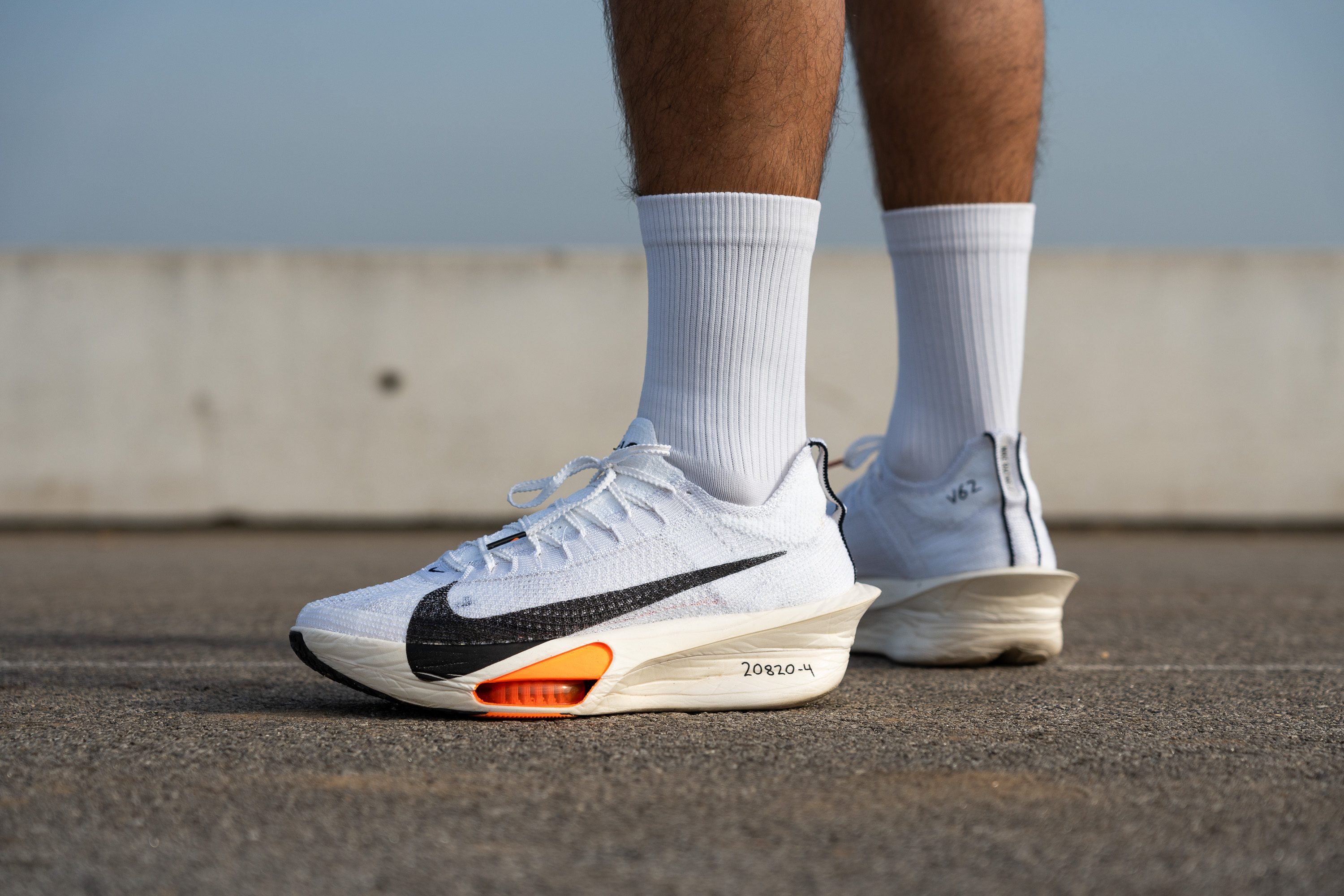
Who should NOT buy
The Alphafly 3 marks a significant improvement, addressing many issues found in earlier models. However, the selection of supershoes has vastly increased, providing a range of options that might be more suitable for certain runners, especially those who experienced arch blisters in previous versions of this shoe.
For those prioritising outsole durability, we proved in the lab that the Adidas Adizero Adios Pro 3 is the best supershoe. A winner of numerous Marathon Majors, it boasts an exceptional Continental outsole known for its unparalleled grip and longevity. And if Adidas isn't your preferred brand, the Hoka Rocket X 2 serves as an excellent alternative, boasting comparable features.
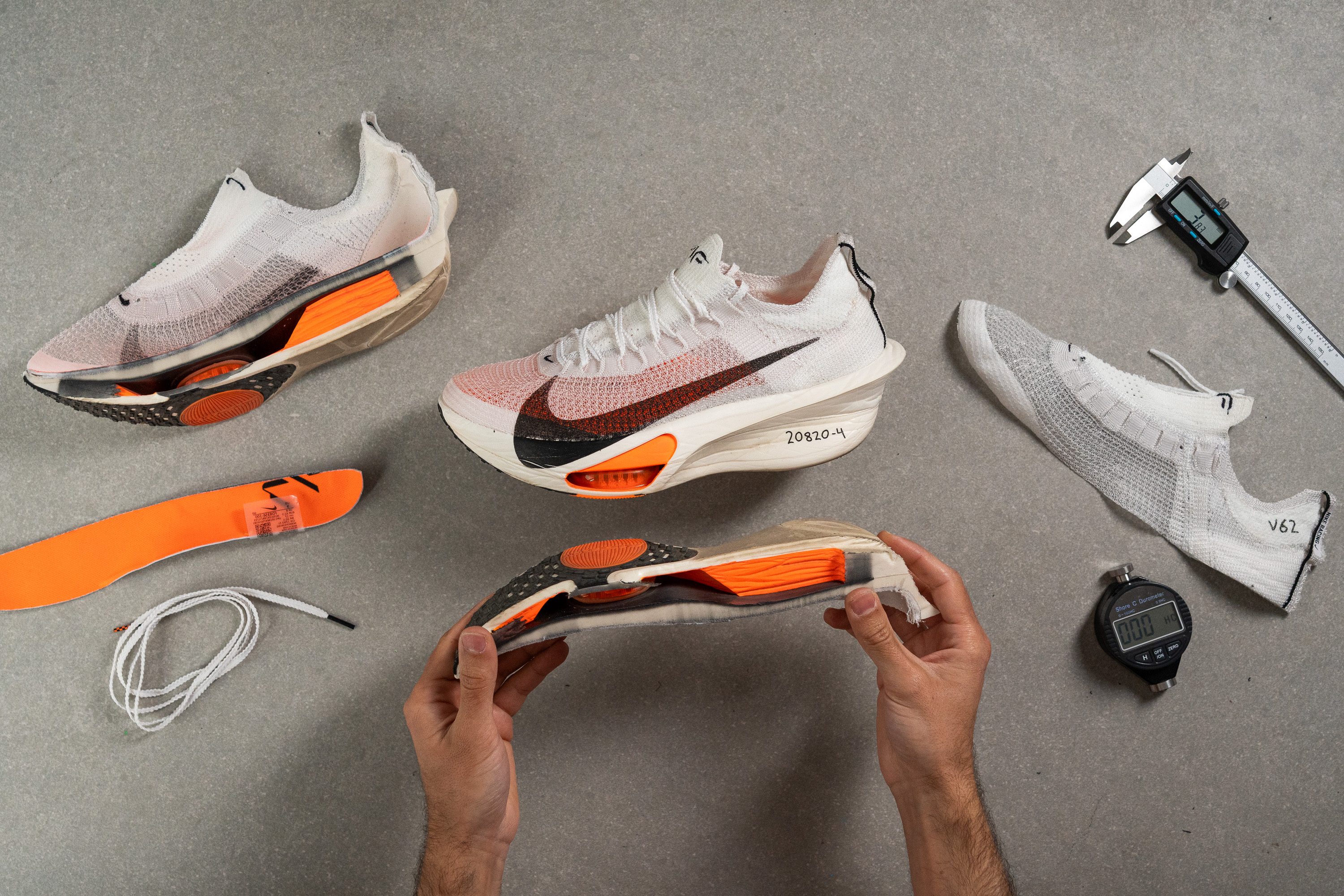
On the flip side, if your priority is minimising weight, the Vaporfly 3 stands out as the pinnacle of lightweight supershoes, weighing in at a feather-like 6.7 oz. And for runners looking for a marathon supershoe without the distinct feel of the Air Pods—or those who predominantly heel strike—the Saucony Endorphin Elite and the On Cloudboom Echo 3 are solid picks.
Cushioning
Shock absorption
The Nike Alphafly 3 reinforces its role as a marathon-ready racer by offering ample shock absorption to keep your muscles fresher deeper into the run. We measured 144 SA in the heel and 113 SA in the forefoot, both above-average scores that align with the shoe’s towering stack height and long-distance focus.
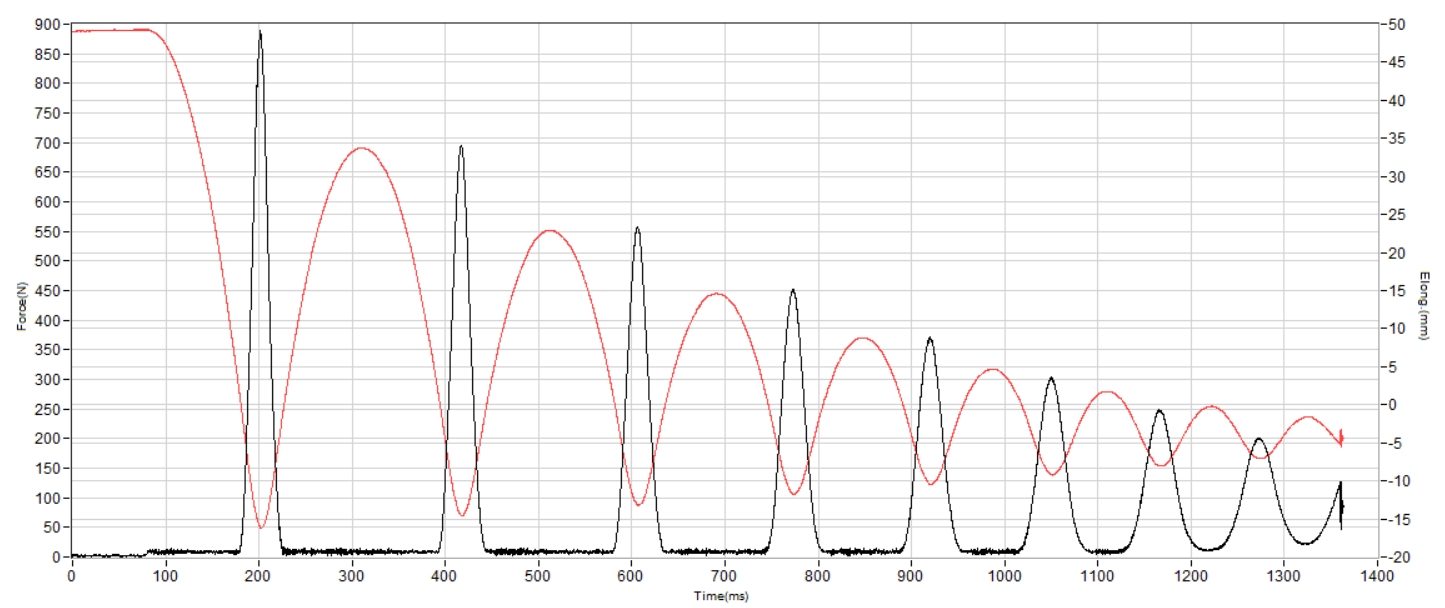
| Alphafly 3 | 144 SA |
| Average | 129 SA |
Energy return
Energy return is excellent at 74.9% in the heel and 73.9% in the forefoot. The Nike Air Pods help counterbalance the lower forefoot stack, keeping the shoe at supershoe-level performance.
Still, Nike might consider an improvement for version 4, as A-TPU materials are now outperforming Pebax and hitting 80% in our lab test.
| Alphafly 3 | 74.9% |
| Average | 58.5% |
Heel stack
We're not here to dive into the endless debate over amateur runners and the 40-mm stack height limit set by World Athletics, but the great news is that it's not a concern with the Alphafly 3.
We took a 38.1 mm measurement in the heel, making it race day legal for everyone. This comes as no surprise, especially since Kelvin Kiptum (RIP) shattered the marathon world record wearing this shoe in Chicago.
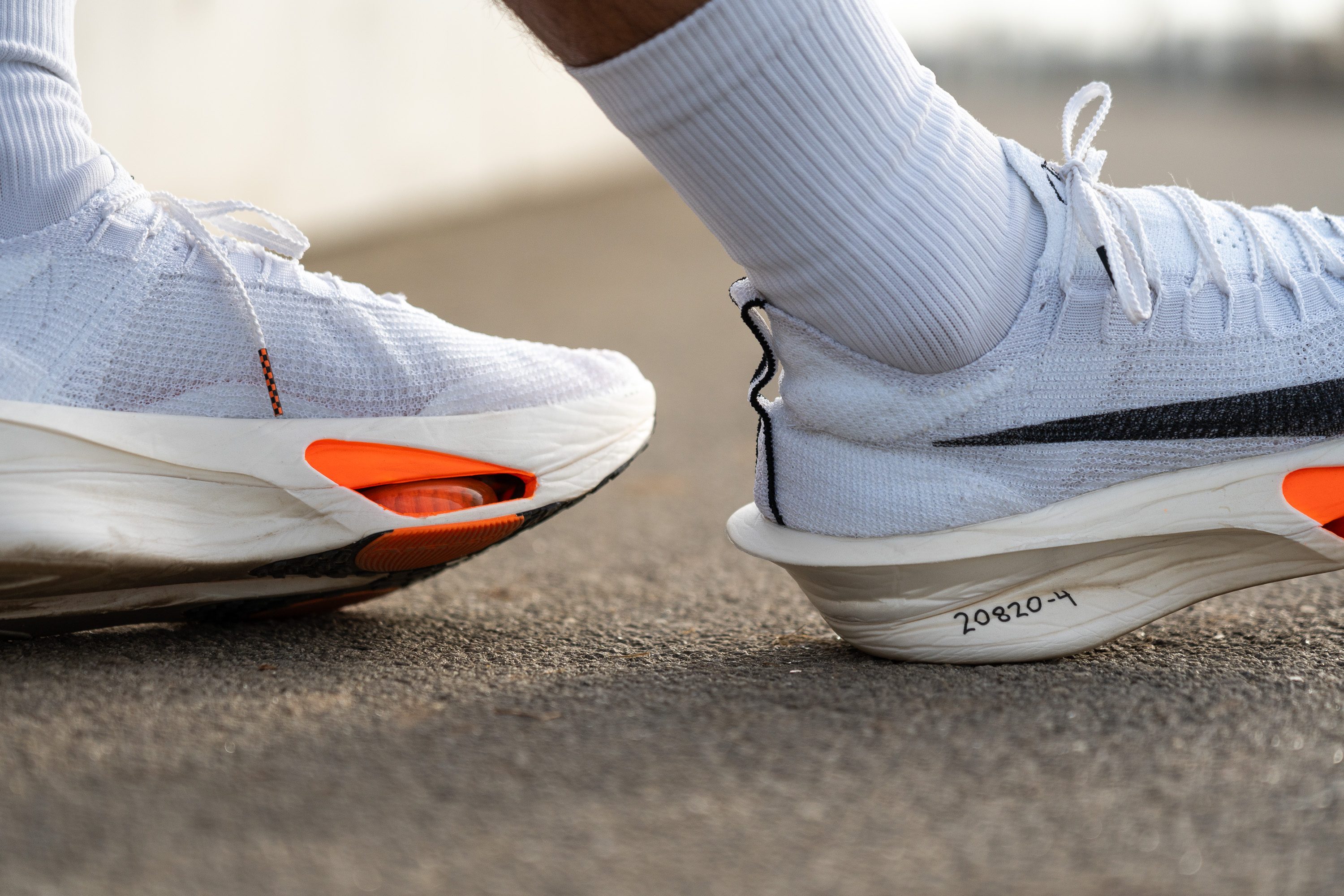
The impressive stack height, filled with the state-of-the-art ZoomX foam, provides exceptional cushioning, even for those who strike heavily with their heels. This is particularly advantageous after mile 20 in the marathon, when numerous midfoot strikers make involuntary adjustments to their running form and transition to heel landings.

| Alphafly 3 | 38.1 mm |
| Average | 34.8 mm |
Forefoot stack
We then focused on the forefoot, where we found a thickness of 29.6 mm, which is still quite cushioned even for a supershoe.
It's worth mentioning that Nike has repositioned the Air Pods further back in the shoe, making it more suitable for midfoot strikers. This adjustment also explains why this measurement is slightly below 30 mm, as the thickness increases by a few millimetres in the area where the Air Pods are located.
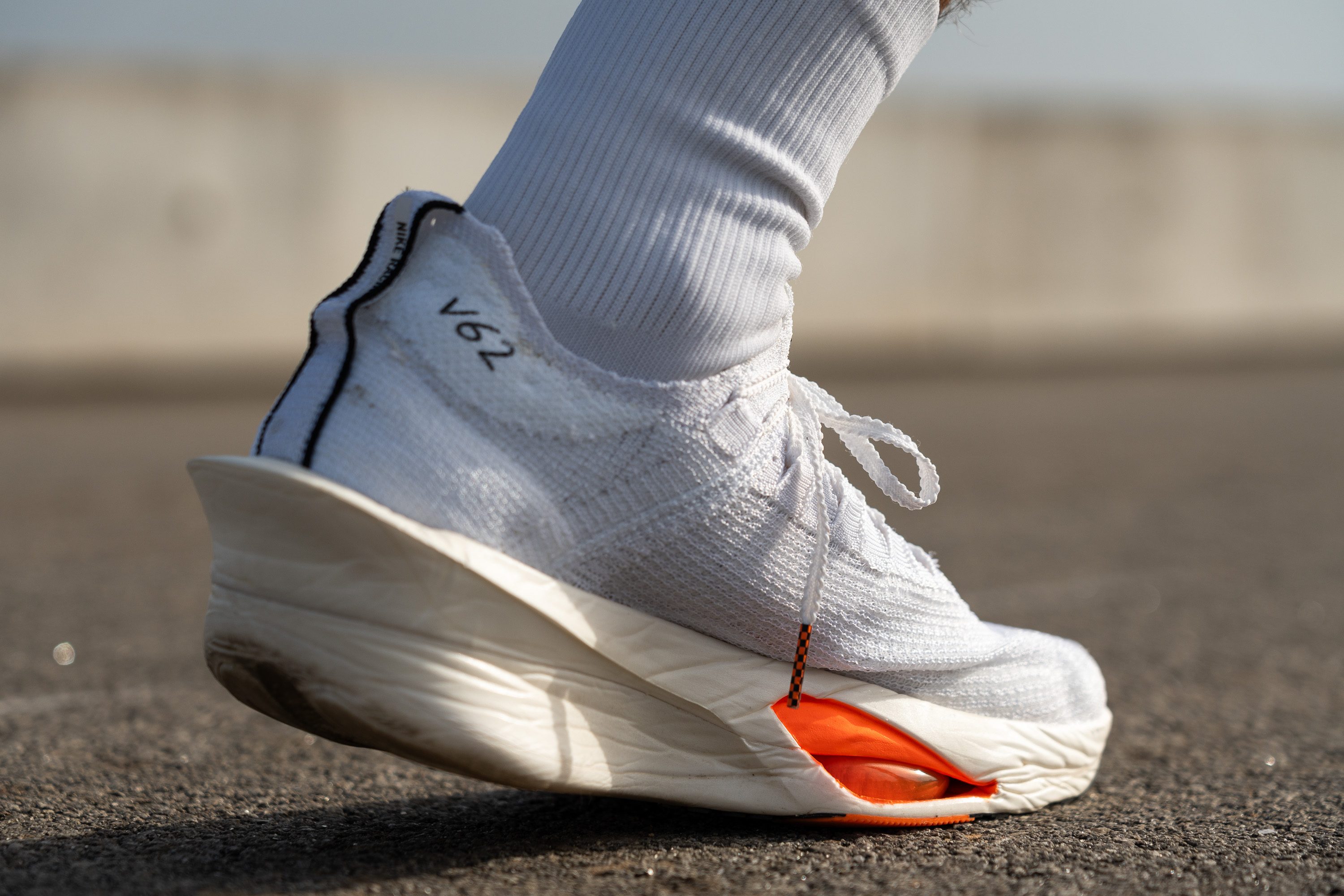
For comparison, in the Alphafly 2, the measurement we took the measurement right at the end of the Air Pods—following the same World Athletics measurement points—resulting in a higher figure of 33.9 mm. However, we didn't perceive the AF3 as having less cushioning than the AF2 in any way.
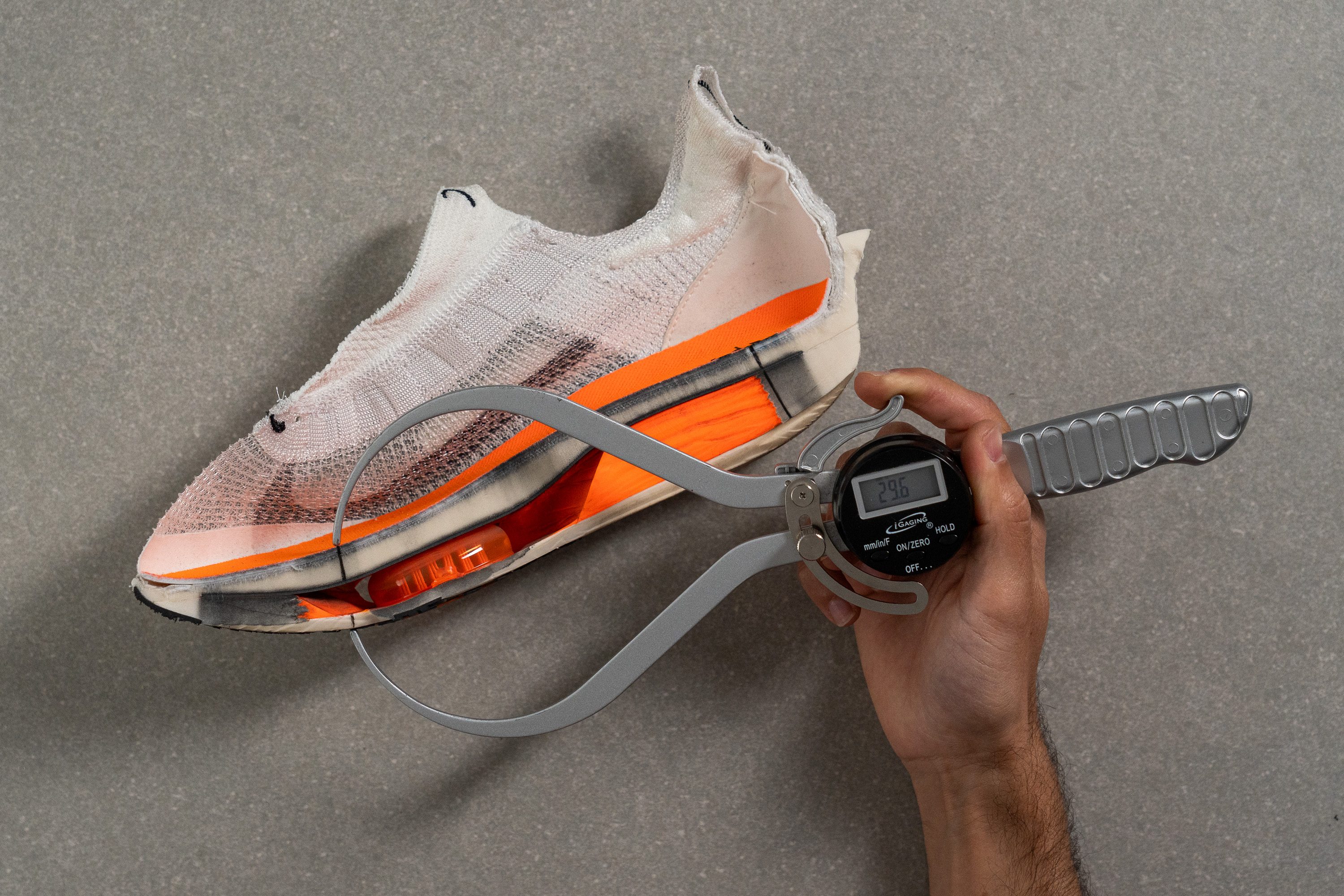
| Alphafly 3 | 29.6 mm |
| Average | 26.2 mm |
Drop
The nearly identical forefoot and heel measurements result in an actual heel-to-toe drop of 8.5 mm, impressively close to the official 8-mm figure. This drop, the same of the Vaporfly, ensures the Alphafly is versatile, accommodating all running styles.
For those curious about stack height details and the surrounding debate, World Athletics lays out two clear guidelines:
- Stack height should be gauged at the shoe's centre, not its edges.
- The forefoot measurement is taken at 75% of the shoe's inner length, while the heel measurement is taken at 12%.
We maintain a rigorous adherence to these standards when measuring every shoe in the lab, which guarantees the complete reliability of our data. Besides, it's worth highlighting that our distinctive practice of cutting shoes in half is the only way to accomplish this level of accuracy.
Finally, it's also crucial to note the major change from the original Alphafly. If you're a fan of the AF1's flatter, 4-mm ride, this update might not be for you. Conversely, runners who struggled with the lower drop will likely find the Alphafly 3's 8-mm heel-to-toe drop a significant improvement.

| Alphafly 3 | 8.5 mm |
| Average | 8.6 mm |
Midsole softness
Like every Nike shoe since the debut of the Vaporfly 4%, Nike continues to employ a dual-density foam setup, featuring a plush lower layer and a firmer upper layer, with the carbon-fibre Nike Flyplate sandwiched in between.
With our durometer, we measured 18.1 HA on the lower, softer layer, which is slightly softer than the v2 that some considered too firm. For precise durometer results, it's essential to measure the midsole directly by cutting the shoe in half, bypassing the outer layer that often features protective elements, contours and bumps.
We believe Nike struck an excellent balance here. While running, it feels even softer than the numbers suggest, thanks to the generous use of ZoomX foam, but don't expect a marshmellow-like ride, it's much more aggresive and bouncy.
ZoomX, highlighted in our ultimate foams guide, it's Nike's premier foam and ranks among the best in the market for energy return. It's made from Pebax by Zotefoams (ZOTEK® PEBA), and offers an incredibly responsive, leg-saving experience that we absolutely enjoyed in the Alphafly 3.
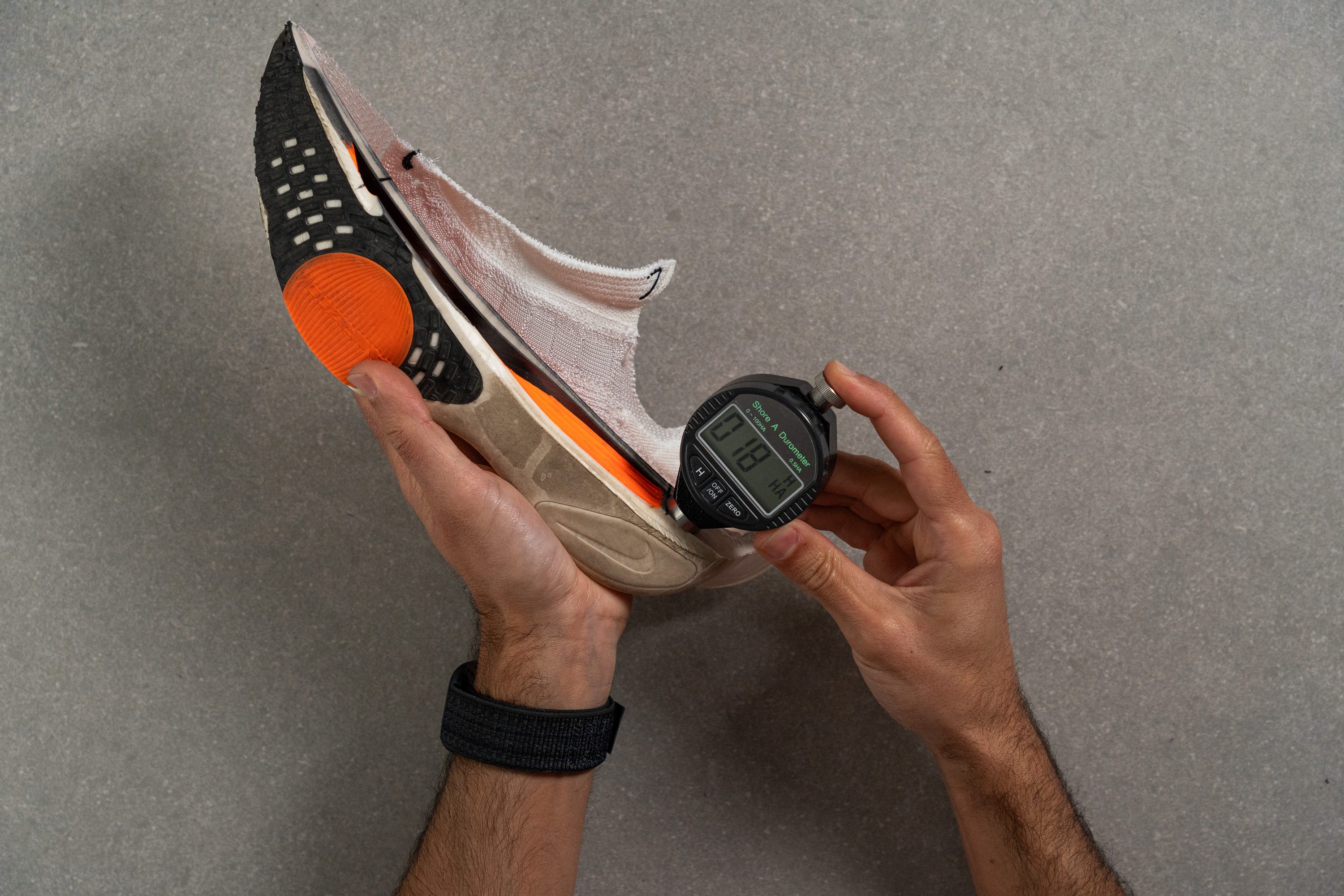
| Alphafly 3 | 18.1 HA |
| Average | 20.4 HA |
Secondary foam softness
The secondary foam, which is closer to your feet, is much firmer, and we clocked it at 29.3 HA. This is clearly intentional to improve stability and ground contact time.
This upper layer of ZoomX foam, along with the Air Pods, provides a relatively firm ride in the forefoot—a stark contrast to the incredibly plush heel, which has more foam and lacks the pods. That's also why we believe that midfoot strikers are the ones that get the best bang for their buck with the Alphafly 3.
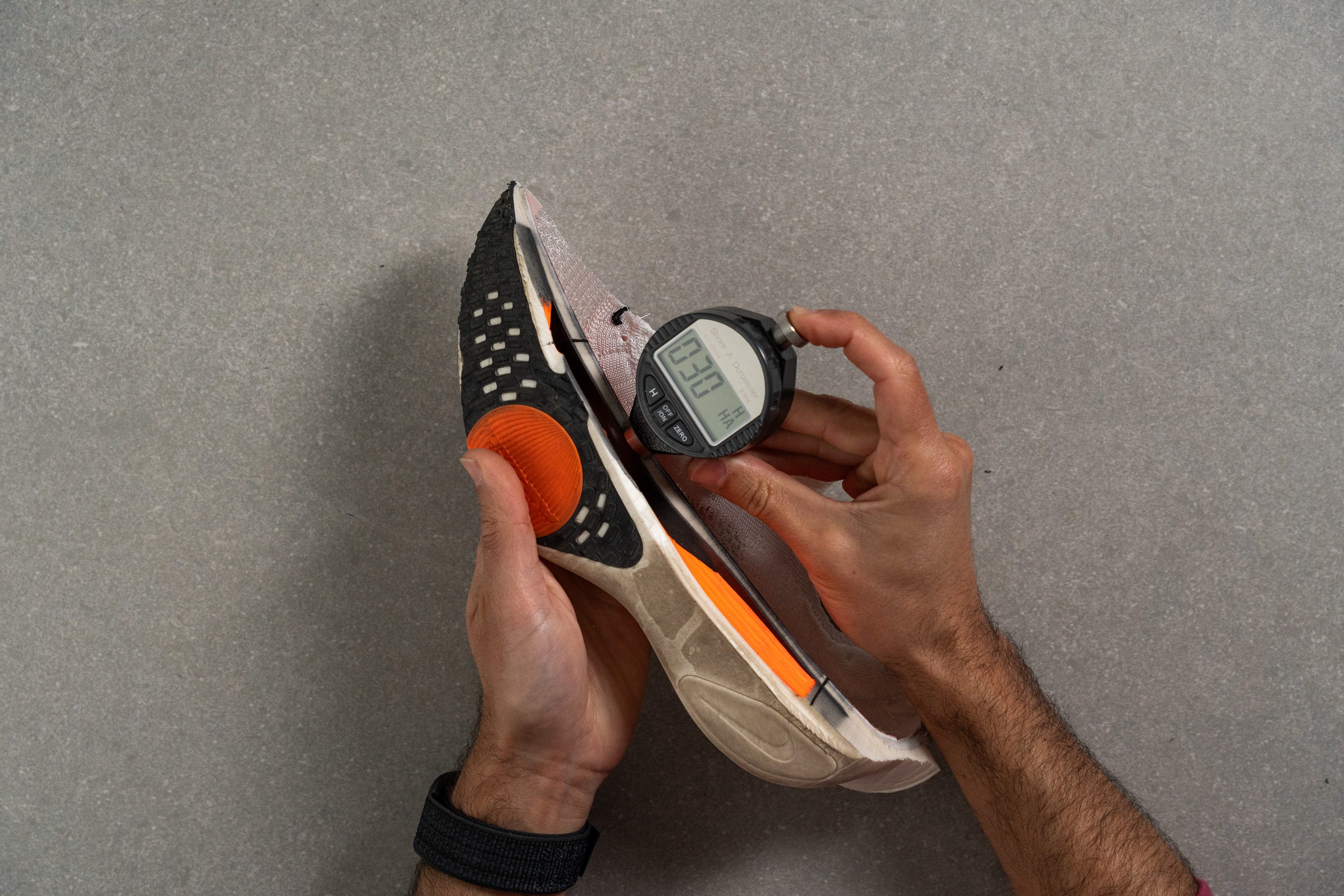
| Alphafly 3 | 29.3 HA |
| Average | 22.7 HA |
Rocker
The Alphafly 3 introduces a significant, early-stage rocker in the forefoot, moving away from the pronounced heel rocker found in its predecessors.
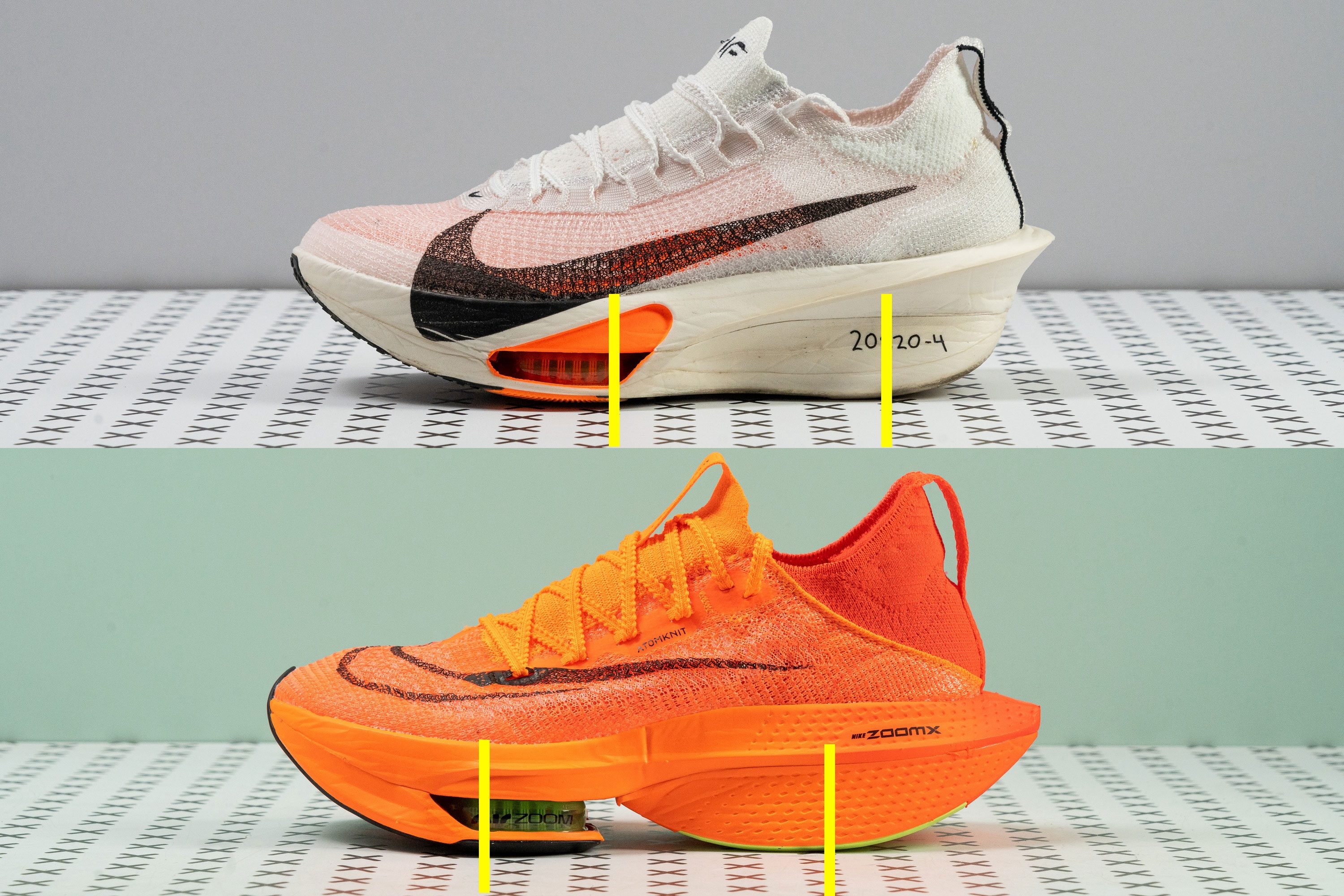
This shift in design makes the AF3 particularly well-suited for midfoot and forefoot strikers, optimising their natural stride and efficiency. Conversely, the Alphafly 2, with its more pronounced heel rocker, might be better suited for heel strikers who benefit from the enhanced heel-to-toe transition that this feature provides.
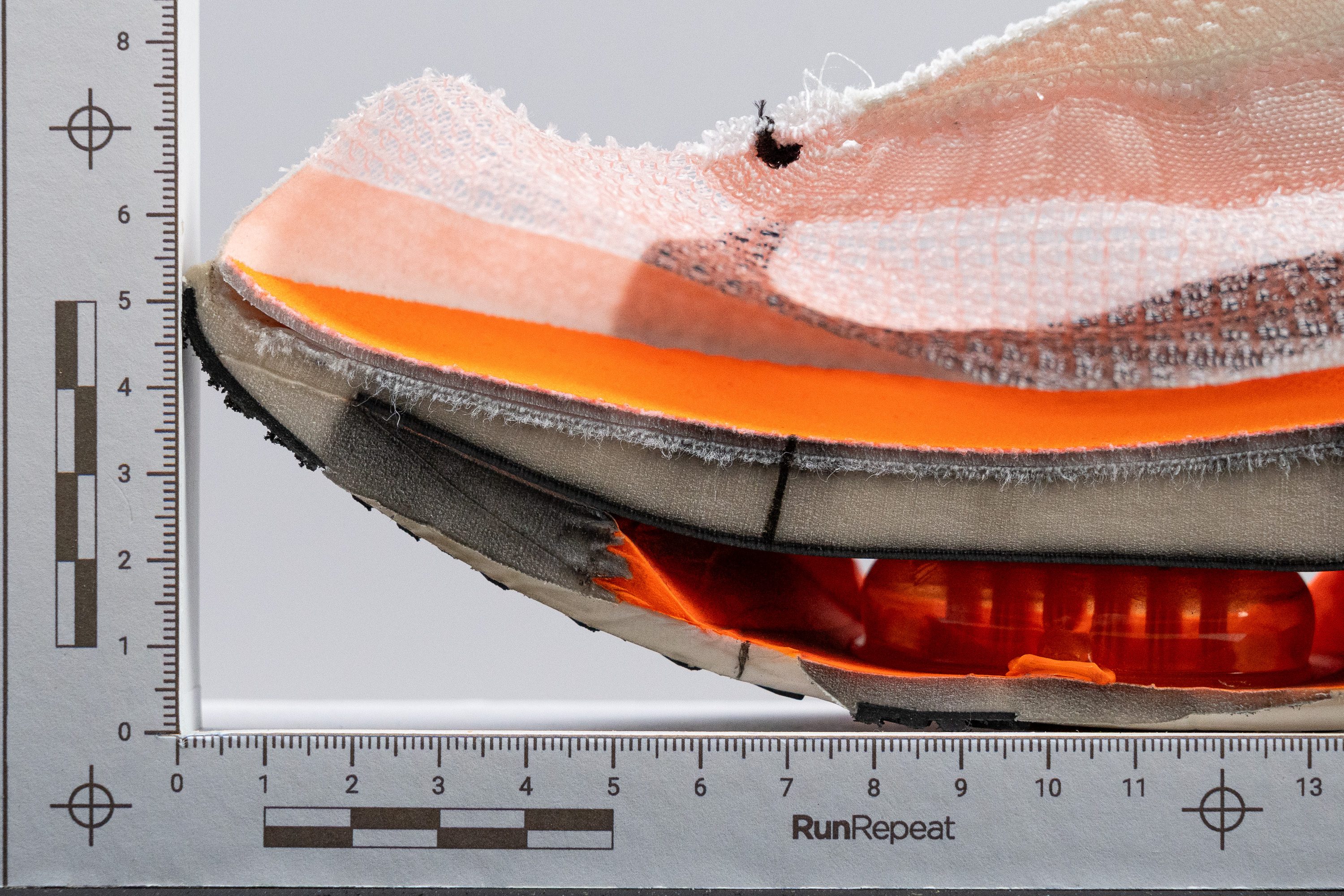
To provide better clarity, we took two pictures of both Alphafly models in the exact same position, clearly showing how Nike has shifted the rocker and Air Pods further back.
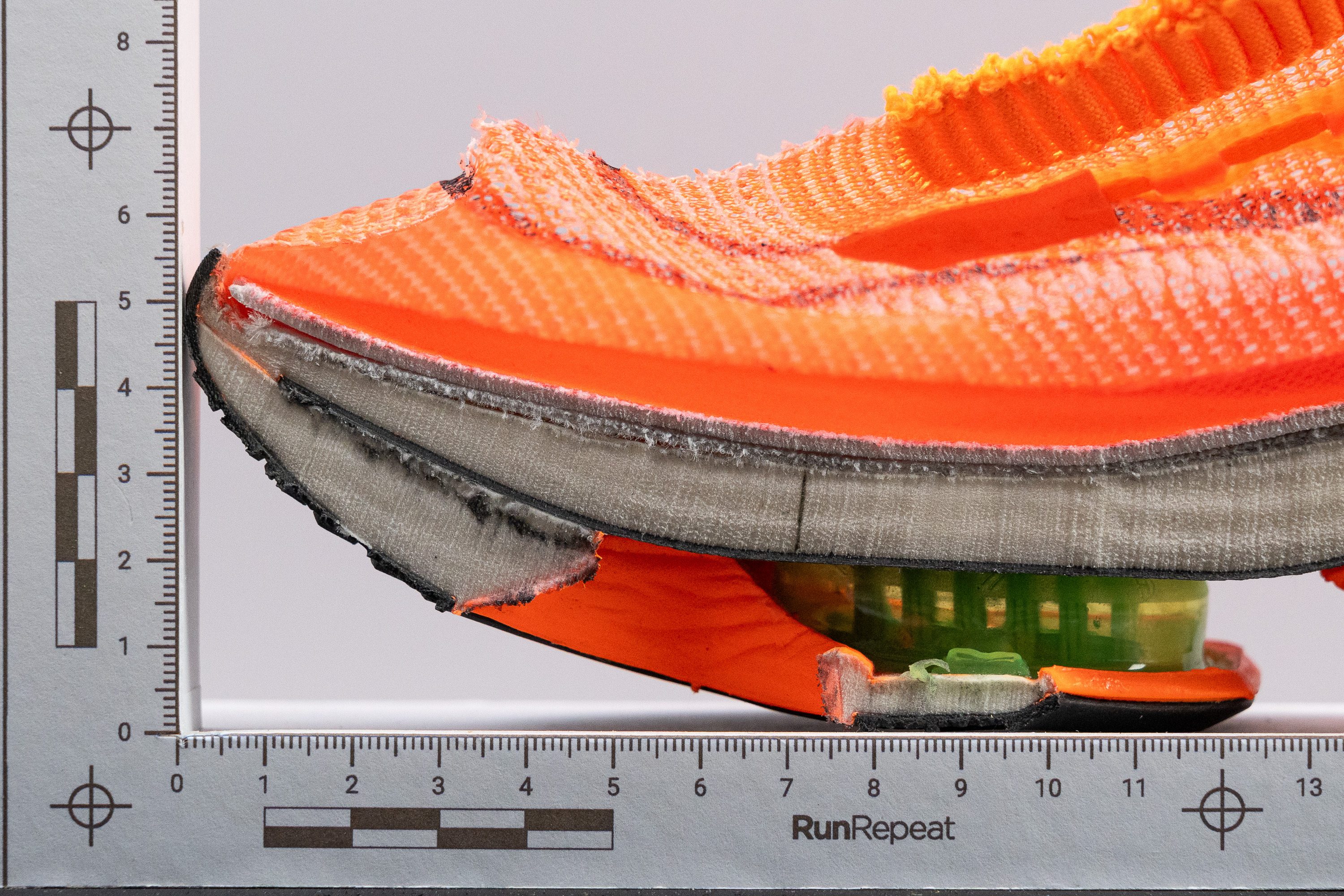
Does this mean heel strikers can't use it? Absolutely not! In fact, some heel strikers do really well with less-rockered shoes. However, we think that if you prefer the benefits of a more pronounced rockered geometry in the rearfoot, you might also find that in a hybrid between a training and competition shoe, like the ASICS Superblast.
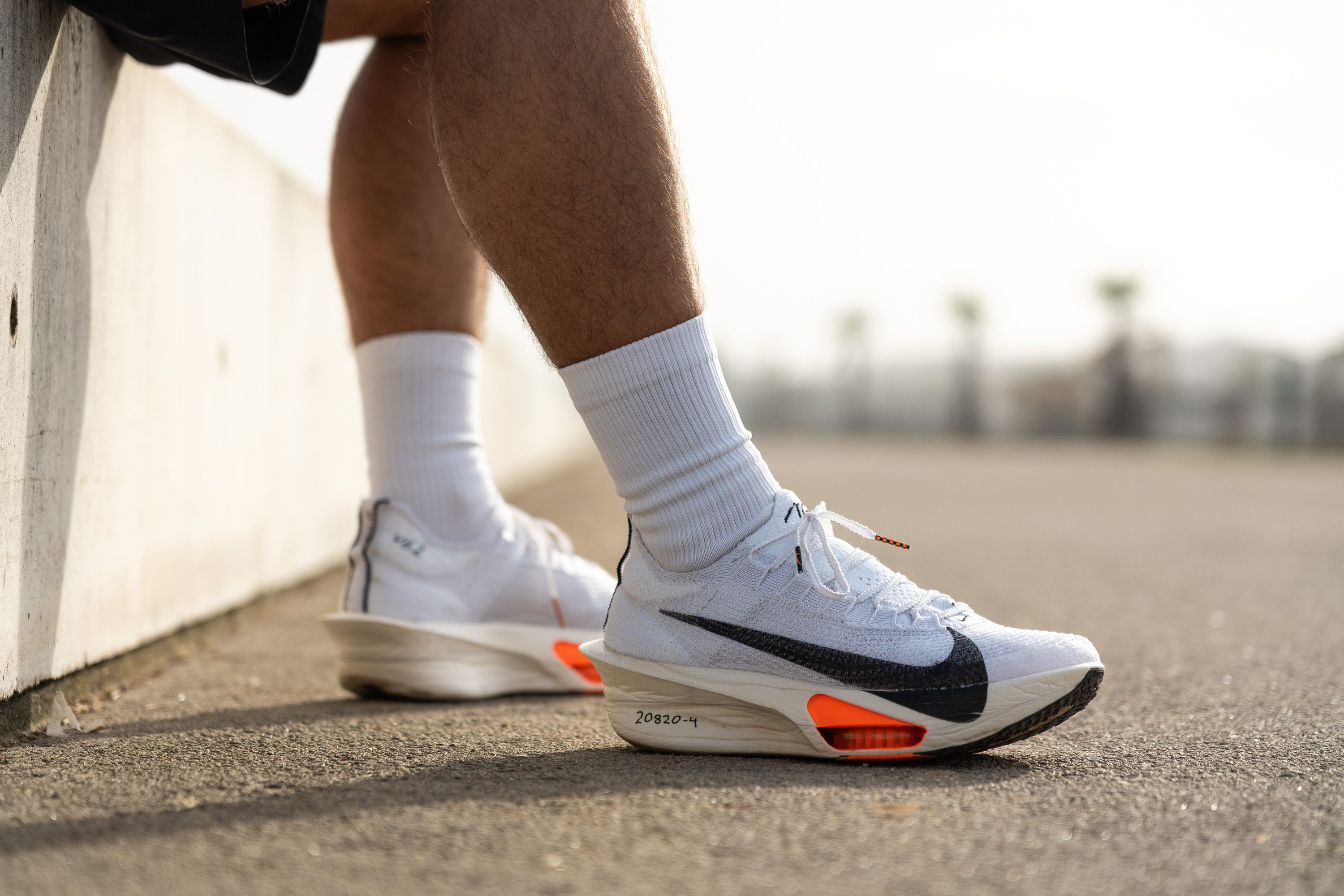
Air Pods
The signature feature of the Alphafly has always been its Air Pods. In our opinion, it's crucial to engage them correctly to fully benefit from this shoe. However, this time Nike crafted them to slightly protrude from the outsole, ensuring they make contact with the ground as soon as possible.
The Air Pods offer a distinct sensation that some runners might find mechanical, a trait particularly noted in the first version. To address this, Nike added some ZoomX foam beneath the Air Pods in version 2, a design choice carried into the third iteration. However, they're still pretty noisy!
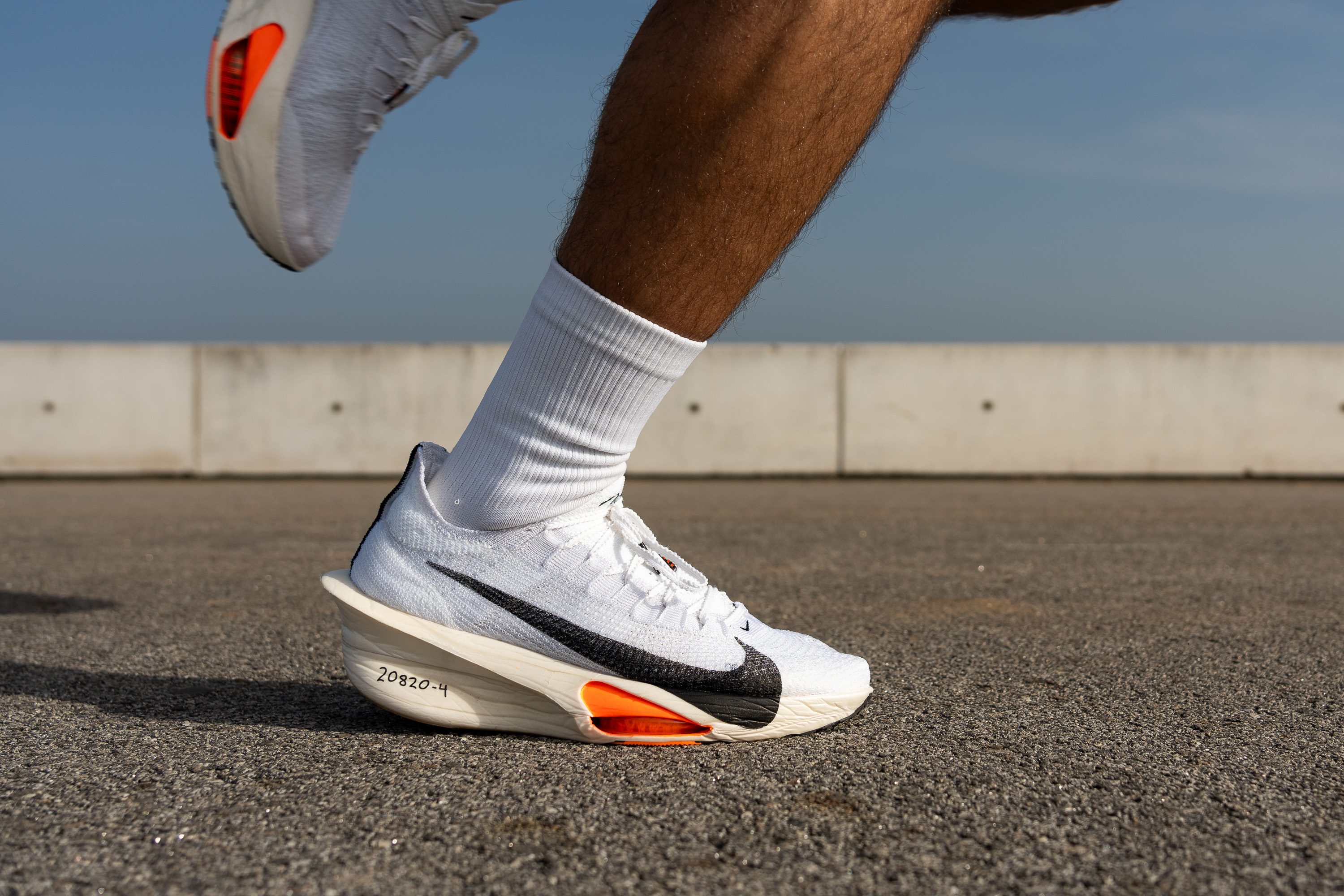
Moreover, the continuous midsole of the Alphafly 3 makes the shoe less clunky for some runners and brings it closer to the feel of the Vaporfly, so it's better suited for faster paces and a quicker turnaround.
Indeed, during a test run that we performed in a 10K race, the AF3 performed wonderfully, aiding in securing a long-awaited sub-36 personal best.
Plate
The carbon-fibre Flyplate has undergone some modifications from the Alphafly 2. It now presents a more pronounced incline in the midfoot area, which should help in the last miles of the marathon, when legs start to fatigue.
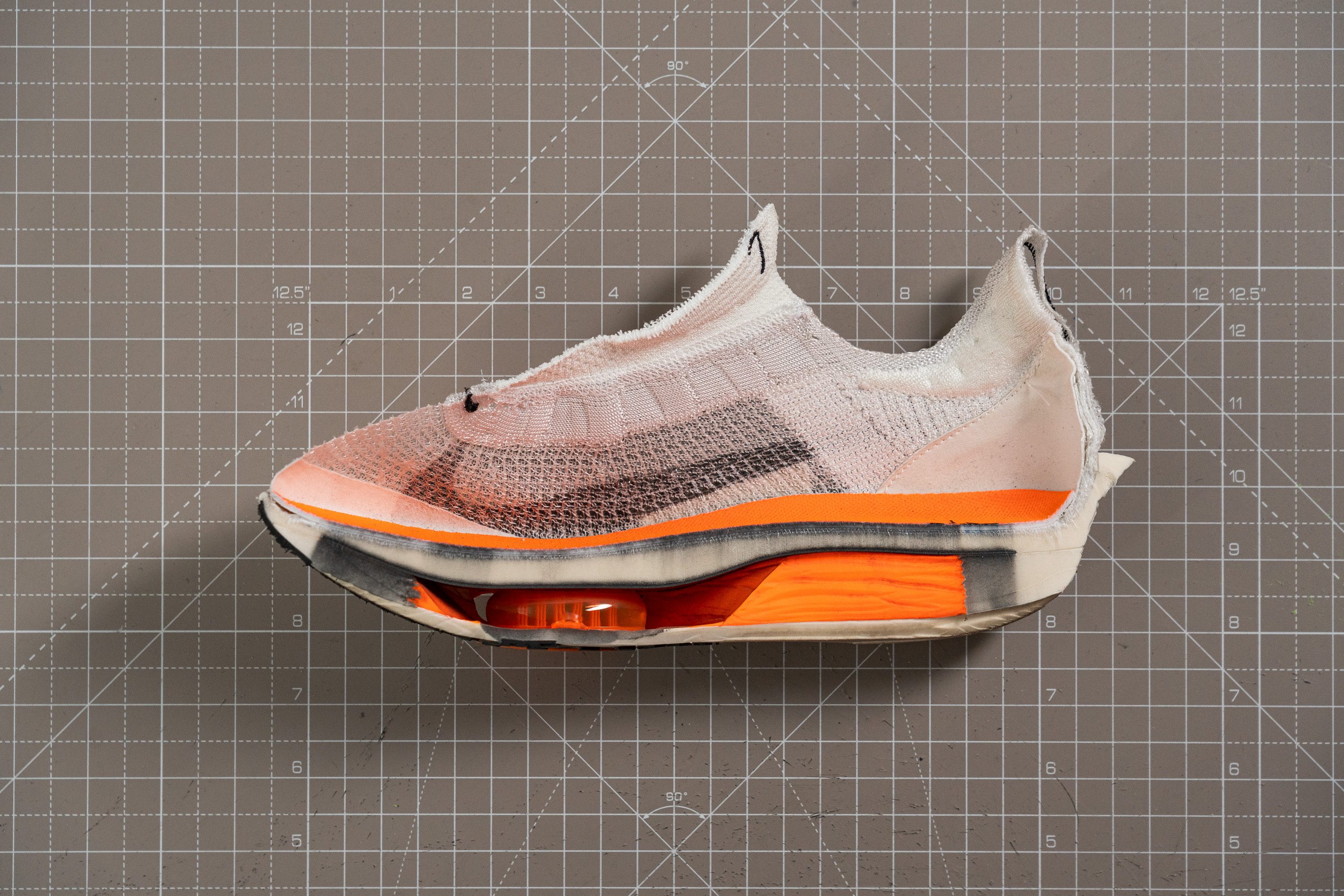
The Flyplate is also one of the significant distinctions between the Alphafly and the Vaporfly. In the Vaporfly, the carbon-fibre plate it's thinner and has a pronounced spoon shape, being closer to the ground. In the Alphafly, that's impossible to achieve that geometry because of the Air Pods.
Anyway, Nike likely prefers the plate's position close to the feet to enhance stability and running economy, preventing excessive sinking into the foam. This is also why we think they opted for a firmer ZoomX foam in the top layer.
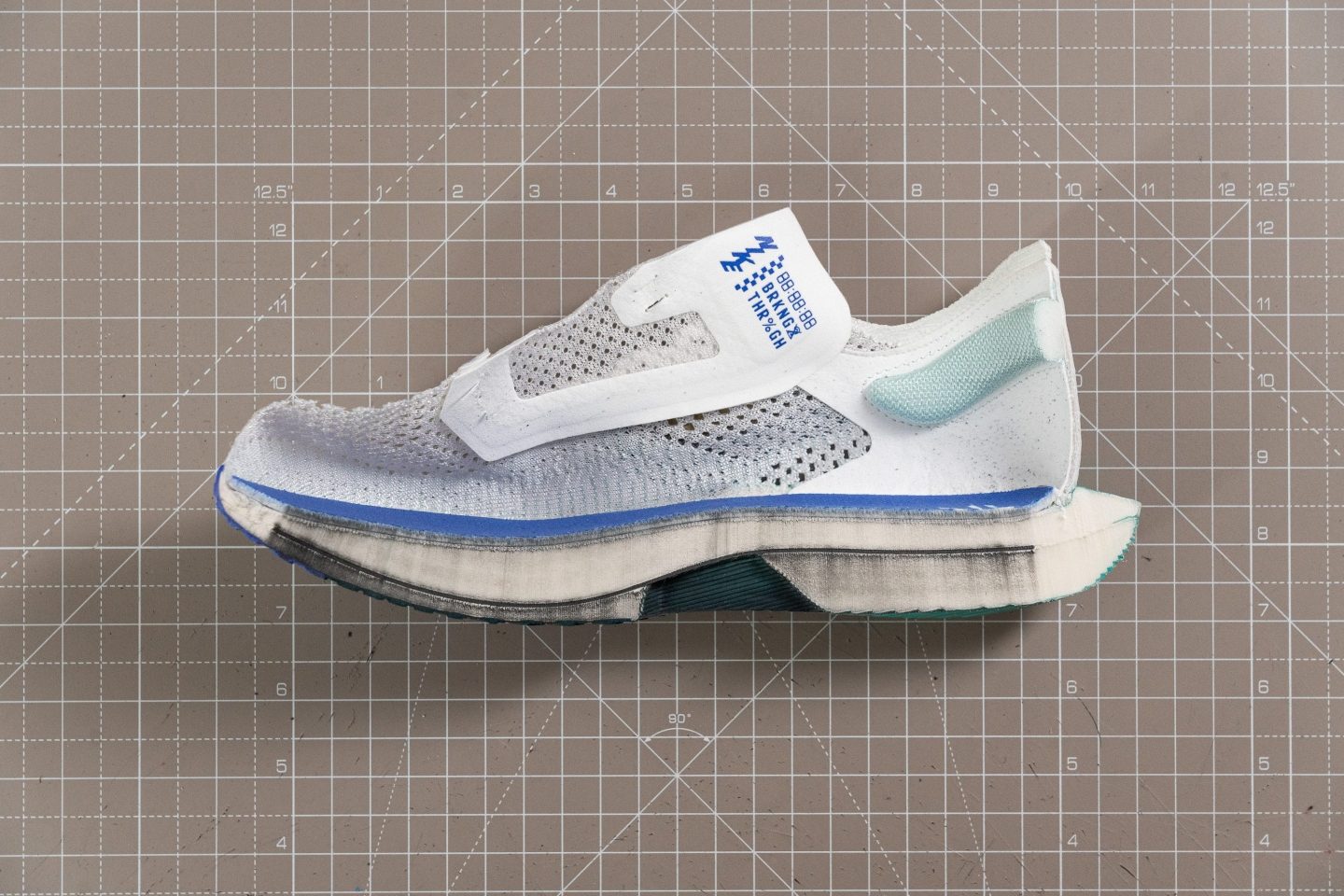
For these reasons, we find the Alphafly excels in long-distance races by boosting running economy and stability. This is especially true for us who lengthen our stride—applying more force to the plate—rather than increasing our cadence to speed up.
On the other hand, the Vaporfly's lively pop and close-to-the-ground plate suits fast efforts like 5K/10Ks or track workouts. We tend to land on our forefoot in those efforts and, upping our cadence to gain speed. Still, preferences can differ, with some runners picking the Vaporfly for longer distances and vice versa.

It's also worth mentioning that having the Flyplate closer to the foot has a side effect—it demands more muscle work in the posterior chain. If you often experience calf strains, the Vaporfly might be a better choice due to its extra ZoomX above the plate, even if you're a stride runner. This is also the reason why we think Nike doubled the Alphafly's drop from v1—it helps to unload the calves.
Size and fit
Size
Nike Alphafly 3 fits slightly small (286 votes).
Width / Fit
Slipping our feet into the Alphafly 3 Proto, we instantly noticed it felt more spacious than previous versions and even a bit roomier than many other super shoes. We also created a gel mould of its interiors to provide concrete evidence.
The measurement we took at the widest part was 93.3 mm. While this might not seem groundbreaking at first glance, it's actually generous for a Nike racing shoe, especially because it's paired with the ultra-stretchy Atomknit upper.
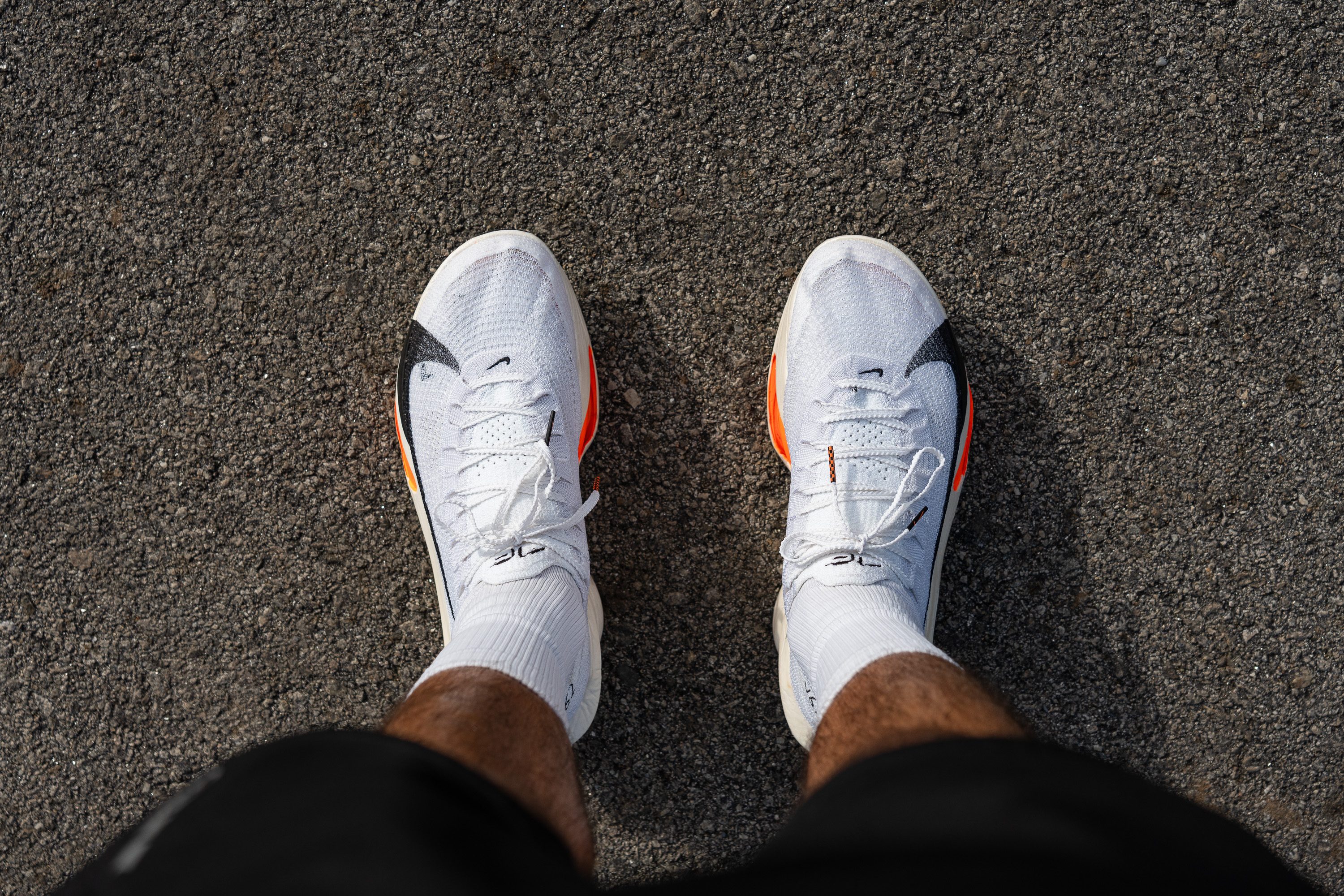
But the real game-changer in the upper's redesign isn't just about width. The crucial update is how Nike has lowered the arch, making the midfoot slightly wider than in previous models, yet we found that it still retains that unmistakable Alphafly feel.
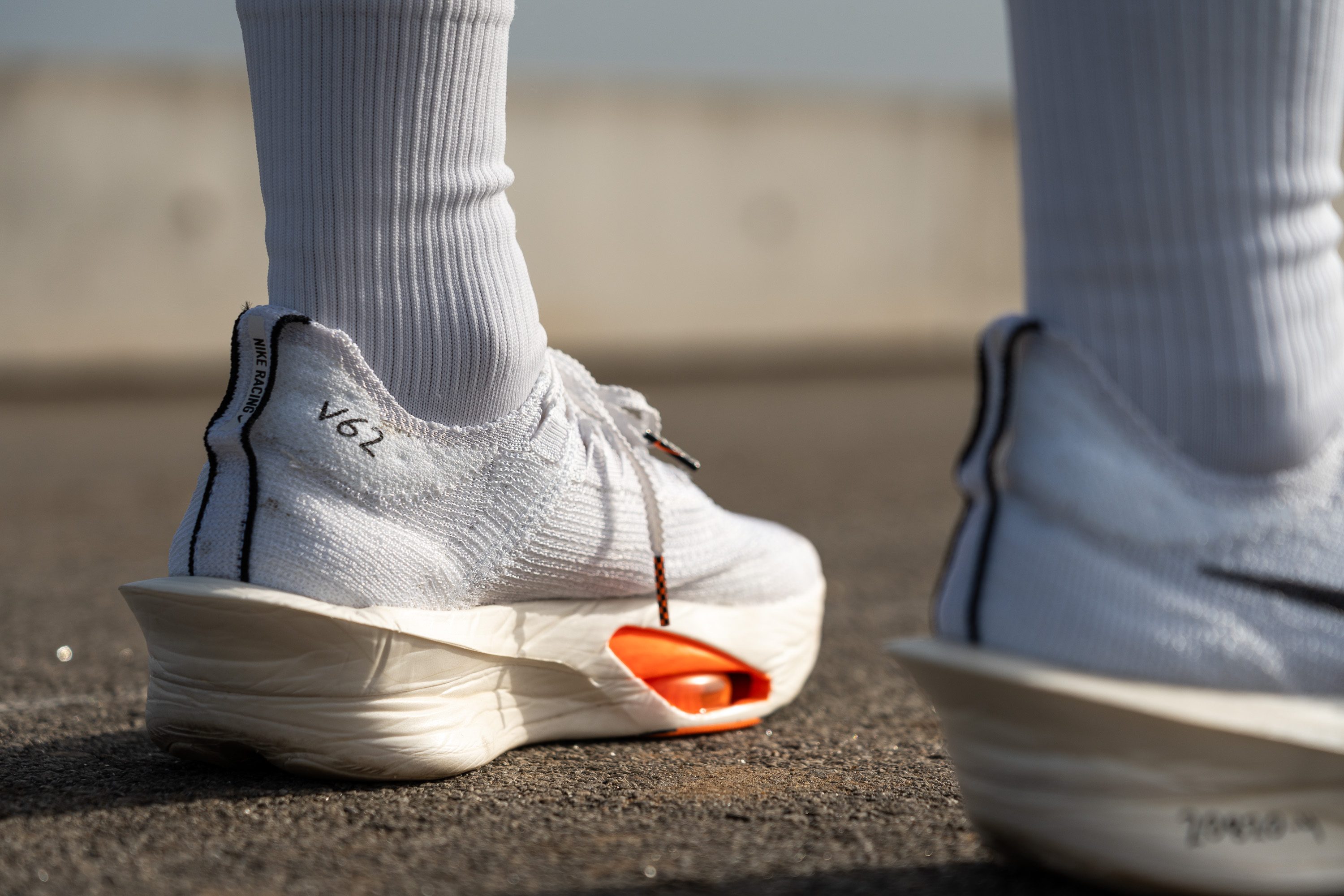
This means those who experienced minor discomfort in the arch with the AF1 and AF2 should find the AF3 much more comfortable. For those who had significant arch blisters or pain in earlier versions, we think this redesign should alleviate some of that discomfort, though it may not disappear entirely.
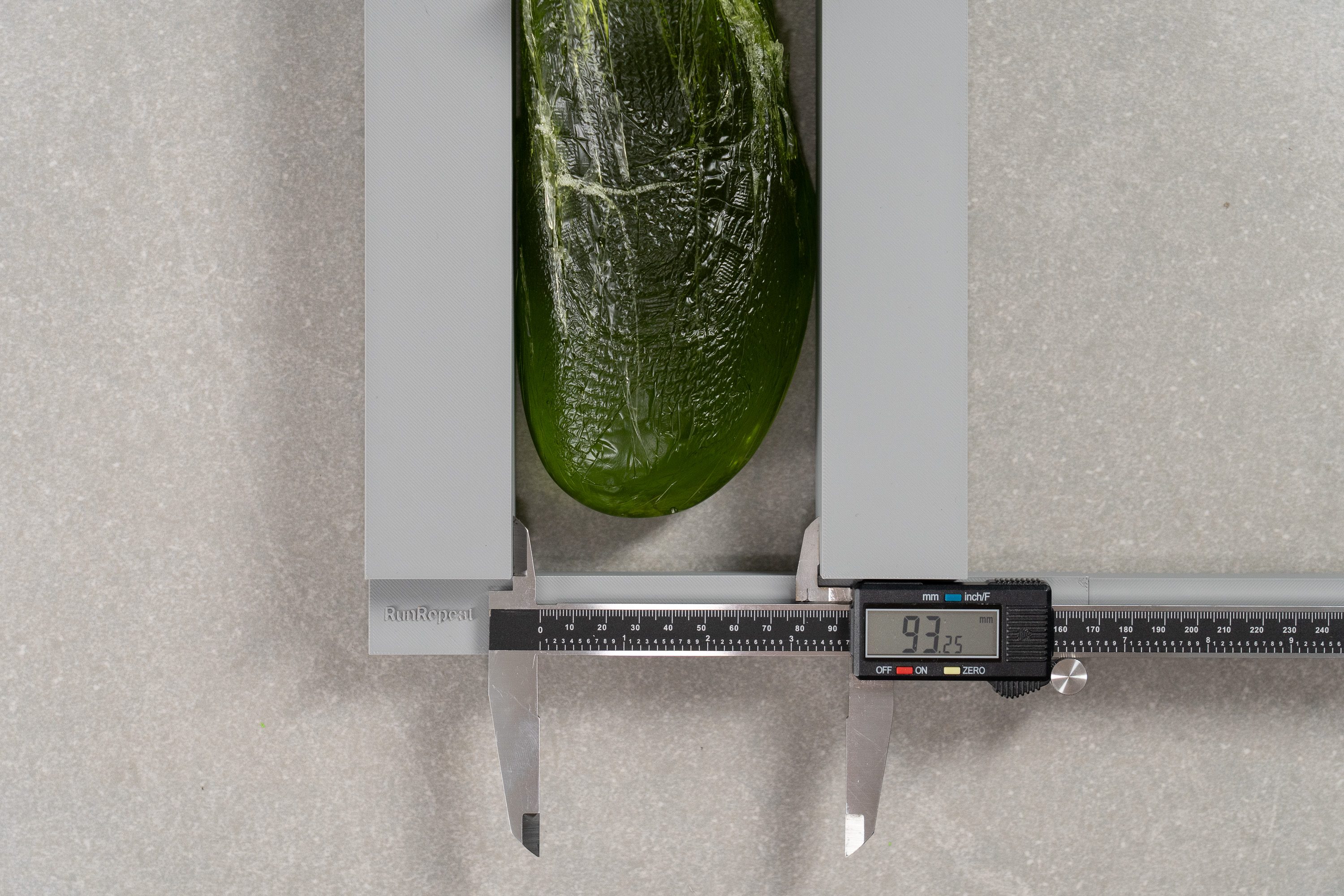
| Alphafly 3 | 93.3 mm |
| Average | 95.1 mm |
Toebox width
Upon measuring the big toe area, we pinpointed the source of the roomy feel. At 75.3 mm, it stands out as exceptionally broad for a racing shoe.
In fact, we used it on two marathons (Tokyo and London) and found that it offers a significant increase in space for the toes to splay in the closing 10K of the race. Applause to Nike for this remarkable enhancement.

| Alphafly 3 | 75.3 mm |
| Average | 73.2 mm |
Toebox height
We found 33.7 mm in height, but there’s a catch. This reflects the maximum vertical room, as the ultra-stretchy Atomknit upper expanded slightly with our gel mould.
But even if you push the upper with your toes, the v3 won't cause any problems. That's quite a contrast with the OG Alphafly, which was infamous for causing black toenails, especially in the big toe.

| Alphafly 3 | 33.7 mm |
| Average | 27.1 mm |
Traction / Grip
Traction test
While a 0.40 in our grip test isn’t a poor result, it still leaves space for improvement on rain-slicked surfaces—especially considering the sky-high price tag of the Alphafly 3. Dry traction, on the other hand, is pretty solid, but we’d love to see Nike refine this outsole further and overtake other supershoes.
| Alphafly 3 | 0.40 |
| Average | 0.48 |
Outsole design
Nike has reinforced much of the midsole with the Fast Shot rubber, particularly in the forefoot area. However, there are exposed sections in the midfoot that may be more susceptible to wear and tear depending on your running form. The ZoomX pods are surrounded by high-abrasion orange rubber segments.
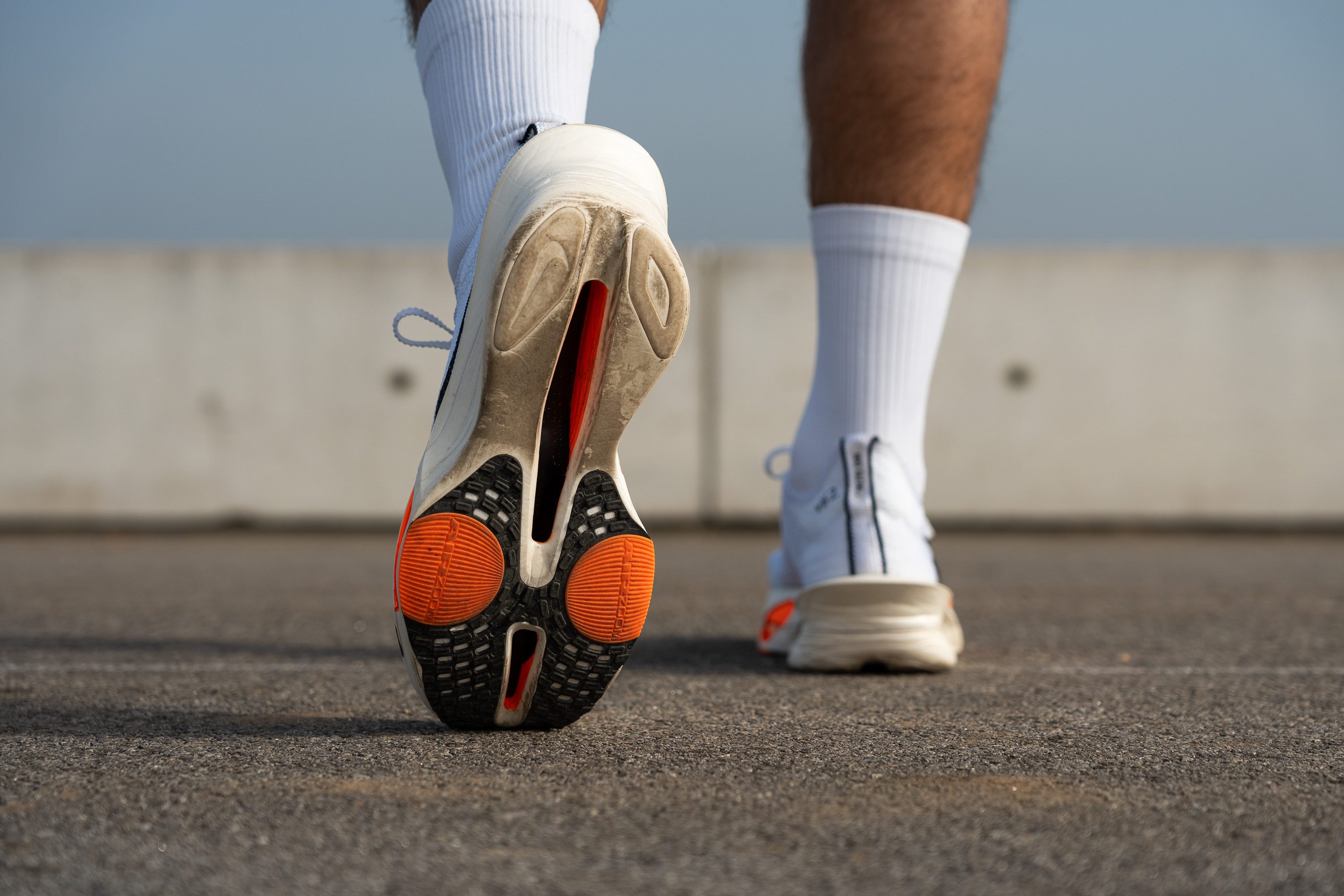
Flexibility / Stiffness
The perfect formula for a super shoe involves blending high-energy-return foam with an ultra-stiff carbon plate. ZoomX foam provides the former, while the latter comes from the carbon-fibre Flyplate.
In our stiffness test, where we flex each shoe to a 30-degree angle in our custom-made machine, the Alphafly 3 proved to be stiff, registering at 28.4N.
This level of stiffness is exactly what we look for in a race-day shoe, so we're thrilled with the result.
However, it's important to note that such stiffness indicates this shoe is purely built for speed. Easy or even moderate runs in this shoe may not only be weird, but also an inefficient use of your money. If you just want the full-length ZoomX experience for easy runs, get the Nike Invincible 3 instead.
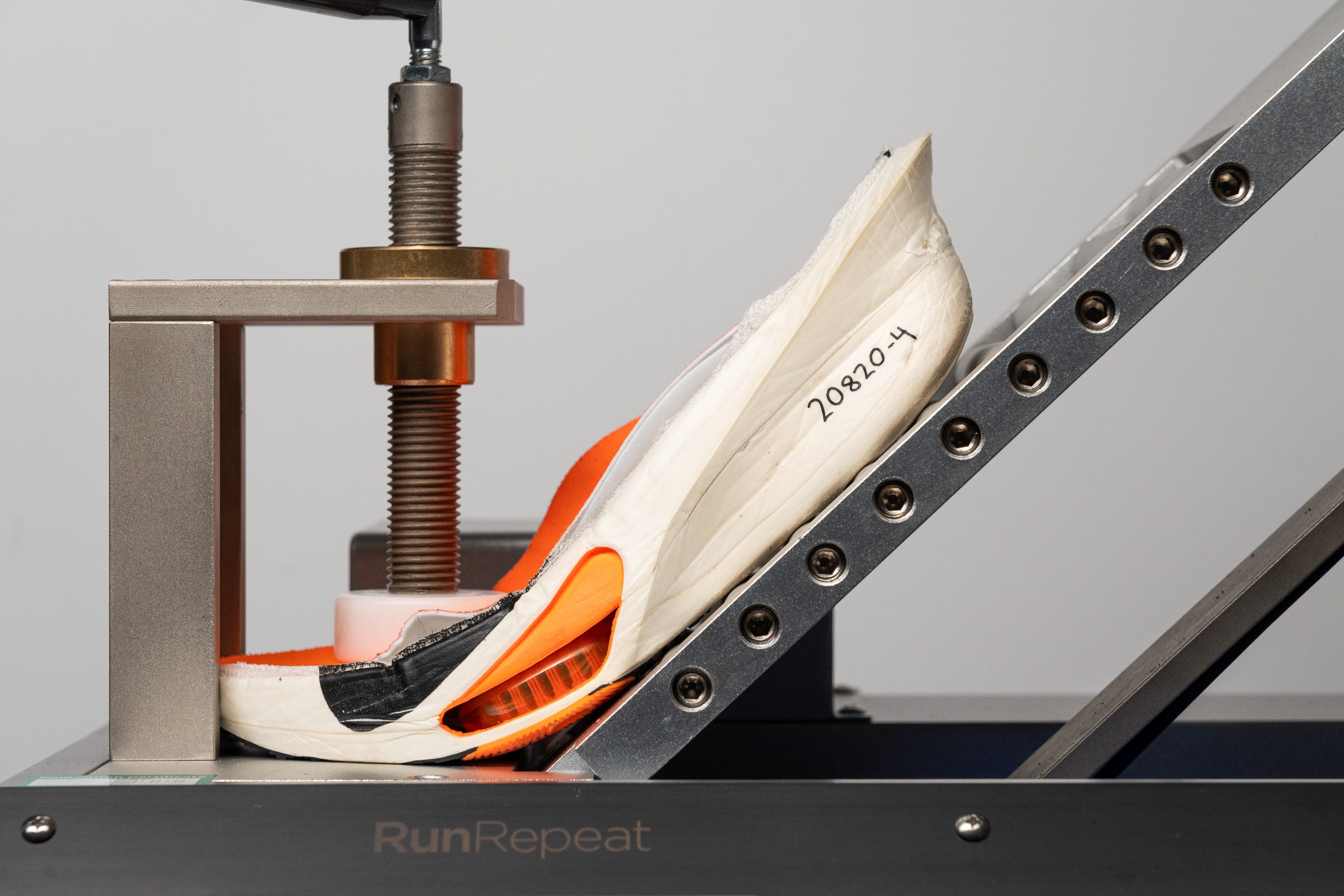
| Alphafly 3 | 28.4N |
| Average | 15.3N |
Stiffness in cold (%)
We performed the 20-minute freezer test again to see how stiff the AF3 gets in extremely cold winter conditions.
Following that, we found that it took us just 4.7% more force to flex the shoe, bringing the total to 75.1N.
| Alphafly 3 | 5% |
| Average | 33% |
Weight
Nike performed a tour de force by crafting the Alphafly 3 to be lighter than the OG Alphafly while maintaining a more accommodating and stable design.
While the Alphafly 2 was by no means a bad marathon shoe, the consensus within the running community—and we agree—was that it was simply too heavy. On our scales, it tipped at 8.47 oz (240g), a hefty 19% more than the Alphafly 3 (7.1 oz or 201g).

So, how did Nike achieve such a remarkable diet? That's where our love for lab testing and dissecting shoes comes into play—we get to uncover the full story.
We found that Nike cleverly eliminated the ZoomX foam around the Air Pods and meticulously sculpted a significant central groove that goes from the heel to the forefoot. This design cleverly allows the Air Pods to expand more, resulting in an enhanced energy return, stability and weight.
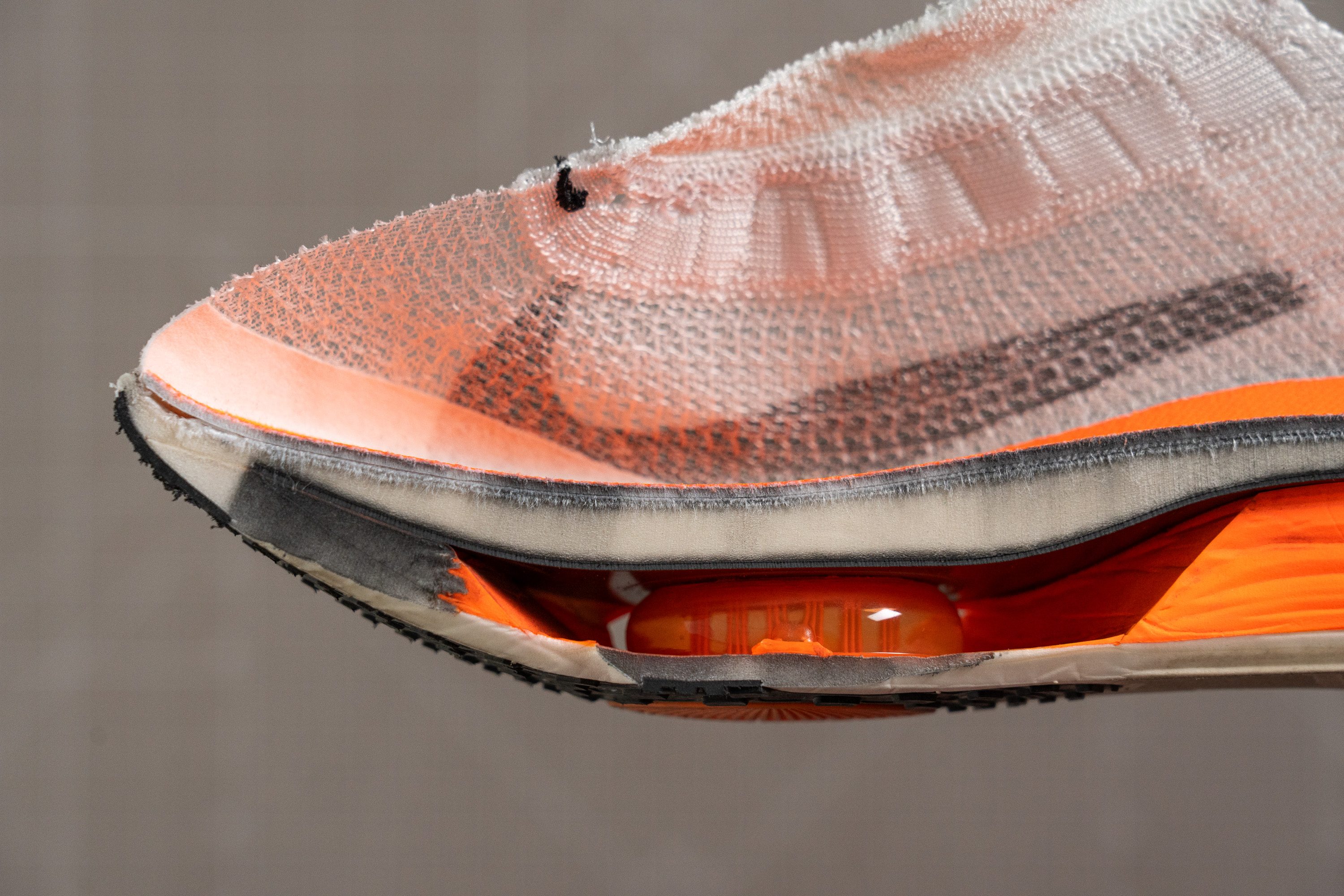
In essence, they combined the best aspects of the AF1's lightness and the AF2's support, enhanced them, and packed it all into one model—the Alphafly 3.
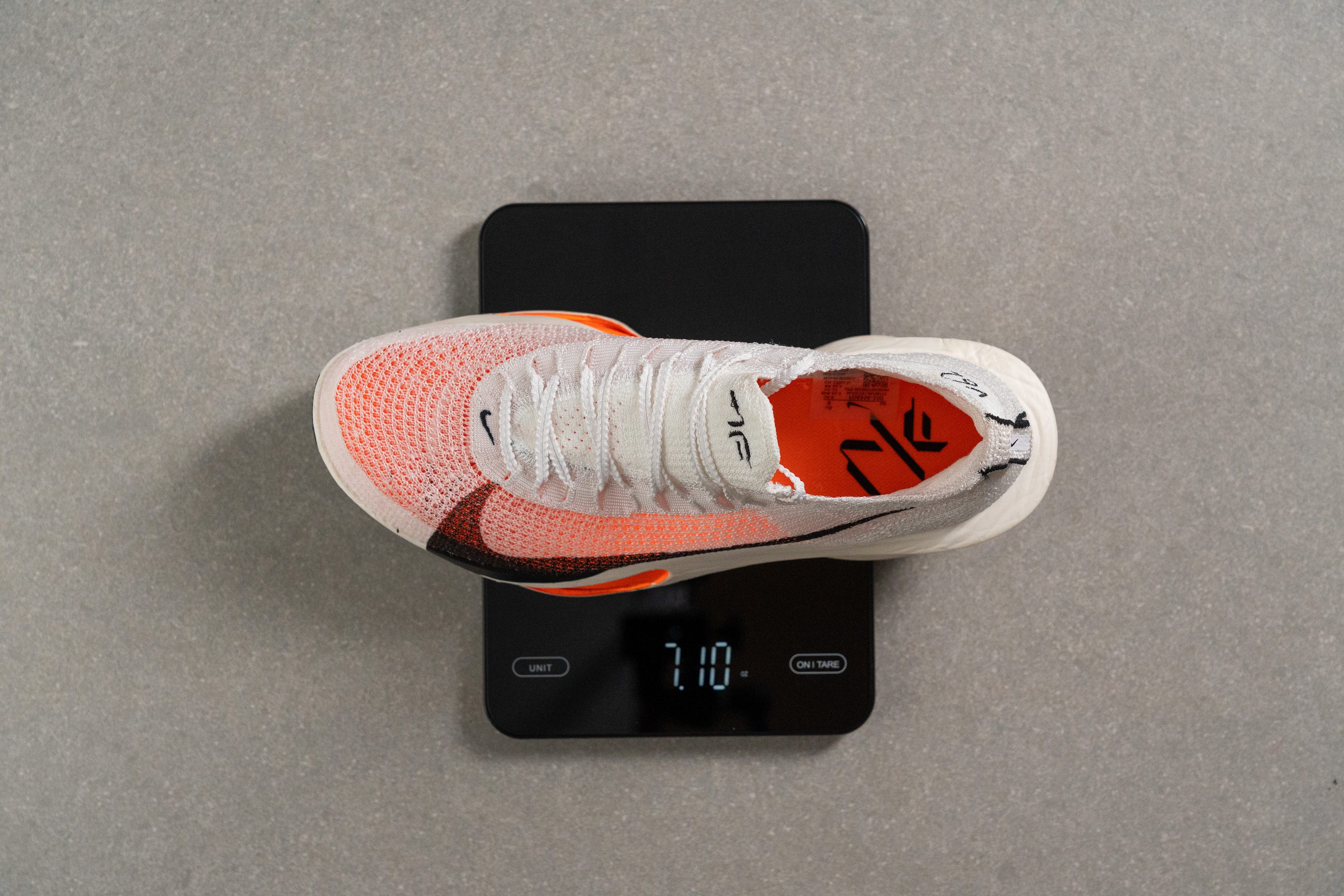
| Alphafly 3 | 7.1 oz (201g) |
| Average | 9.3 oz (264g) |
Breathability
From the moment we unboxed it, we were confident the Alphafly 3 would ace our breathability test. The upper was so visibly airy, it set high expectations right away. But of course, we're here to conduct lab tests, not just make assumptions—and this is a 5 out of 5 for us.
The Atomknit 3.0 upper showcased exceptional ventilation. This guarantees efficient heat management, even during the hottest marathons.
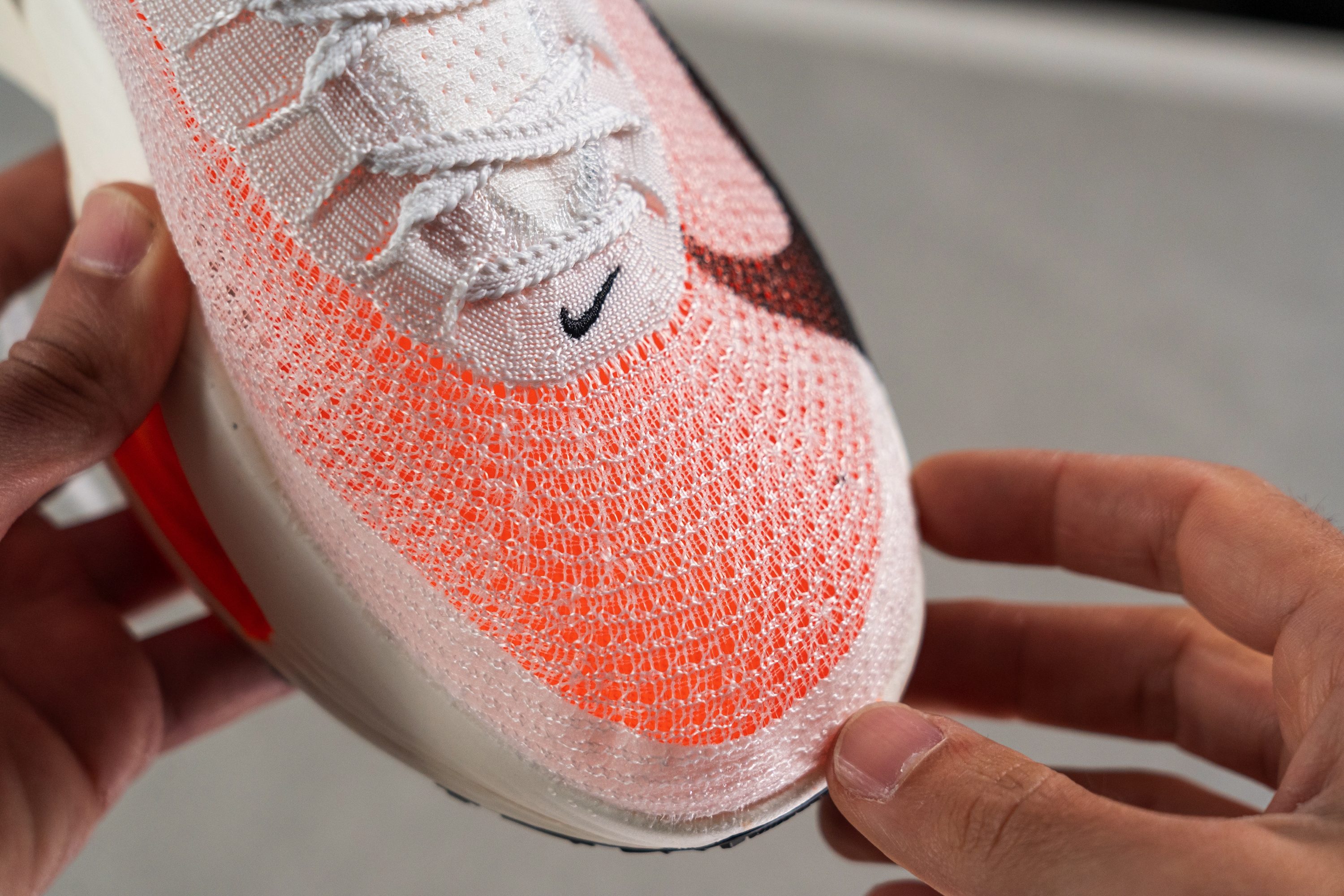
The upper's thin and minimal design allows light to pass through in a way we've hardly ever seen, yet it's surprisingly well-structured, surpassing previous versions.
Turning to the microscope for a detailed view revealed that the Atomknit 3.0 material is not just functional but also strikingly attractive.

Nike masterfully blended robust yarns with thinner, nearly-transparent ones to craft an upper that's both structured and light.
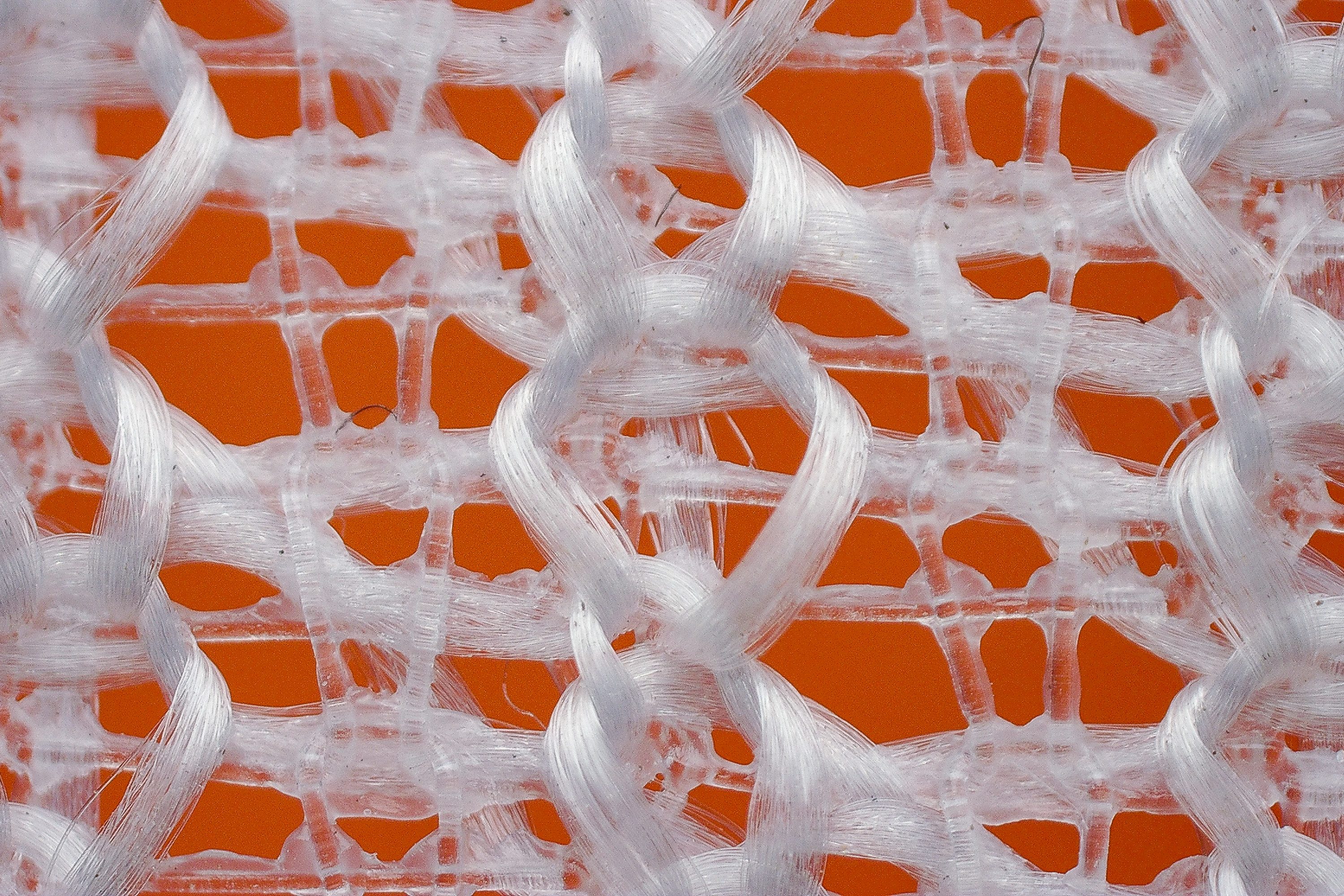
In our detailed examination of the upper, we noticed the heel area is really padded for comfort, while the rest of the upper is designed with a clear focus on minimising weight and maximising breathability.
In summary, the Atomknit 3.0 upper on the Alphafly 3 is nothing short of a masterpiece, embodying the level of engineering and quality that we expect from a shoe priced at £280.
| Alphafly 3 | 5 |
| Average | 3.7 |
Stability
Lateral stability test
A common complaint among users of the first Alphafly was its lack of stability. To address this, Nike widened the shoe in version 2, but this came with an unfortunate side effect—a massive increase in weight.
With the Alphafly 3, Nike swung for the fences and hit a home run, creating a shoe that's more stable than version 2—especially for midfoot and forefoot strikers—and lighter than version 1.
Fortunately, they haven't overlooked heel strikers either, which is evident from the eye-catching midsole flare that extends through the heel and curves around it.

This isn't just a one-of-a-kind, UFO-like design for getting likes on Instagram. It really works, and combined with the midsole sidewalls, performs marvellously by broadening the landing base in the heel and smoothly guiding the feet forward.
Torsional rigidity
As expected from a supershoe, the AF3 comes with a stiff carbon plate, as previously mentioned. This design offers a spring-like, aggressive ride along with significant torsional rigidity.
However, in our lab tests, we gave it a 4 out of 5, which was slightly lower than expected. Why not aim for a 5/5? Excessive torsional rigidity can make the shoe somewhat uncomfortable, particularly over long distances. And it's important to remember that Nike designs the Alphafly primarily as a marathon shoe, where a degree of comfort is essential for those long 26.2 miles.
| Alphafly 3 | 4 |
| Average | 3.5 |
Heel counter stiffness
The heel counter is noticeably lacking in stiffness, offering the race-fit feel we're looking for in this shoe. We gave it a 1/5 rating, which is another reason we think some heel strikers might find it unstable.
For forefoot and midfoot strikers, this design choice is beneficial because it helps reduce the shoe's weight, avoiding the need for rigid elements or TPU reinforcements around the whole heel counter. The AF3 only has a semi-rigid lower half, which is barely noticeable while running.
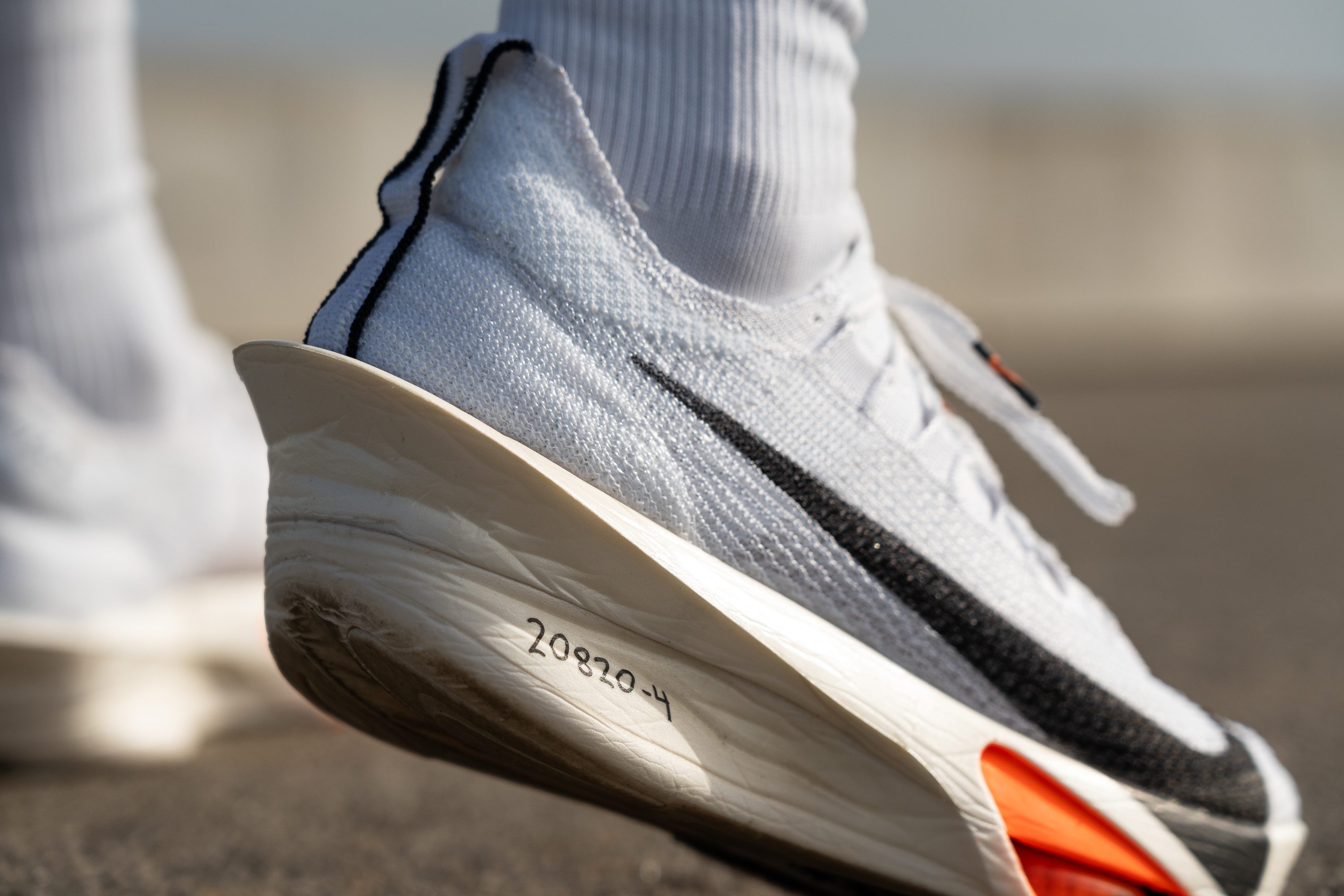
This soft heel counter is also why Nike added ample padding inside the heel, as noted in the breathability discussion. With such a soft area, heel slippage could be an issue if the padding isn't exceptionally effective.
Thankfully, in our test runs and races with the Alphafly 3, we didn't encounter any heel slippage, even without using lace locking—a feature not available on the AF3 due to the lack of extra eyelets.
| Alphafly 3 | 1 |
| Average | 2.9 |
Midsole width - forefoot
The cornerstone of Nike's stability strategy is the midsole width in the forefoot, a brilliant move we've noted here in the lab.
This design, which Nike has smartly adopted—and is also utilised by other brands like Saucony and New Balance—is both simple and ingenious. By emptying out the midsole's centre, Nike managed to widen the shoe without adding weight, as it happened with the previous version.
We found that the central groove in the Alphafly 3 is exceptionally large, extending all the way to the forefoot. This design not only accommodates a more roomy upper but also significantly enhances stability.
To put it in perspective, two of the top mild-stability shoes on the market, the Brooks Adrenaline GTS 23 (117.3 mm) and the Saucony Tempus (117.4 mm), are just shy of the Alphafly 3's width of 117.5 mm.

| Alphafly 3 | 117.5 mm |
| Average | 114.4 mm |
Midsole width - heel
In the heel, our measurement showed a more average width of 91.9 mm. While this might not seem particularly wide at first glance, comparing it to other supershoes in this same measurement can provide some context.
| Shoe | Heel width (mm) |
| Nike Vaporfly 3 | 76.6 |
| ASICS Metaspeed Sky+ | 77.8 |
| Adidas Adizero Adios Pro 3 | 84.0 |
| Saucony Endorphin Elite | 91.3 |
| Hoka Rocket X 2 | 85.2 |
With this comparison, the Alphafly 3 actually appears quite wide, doesn't it?
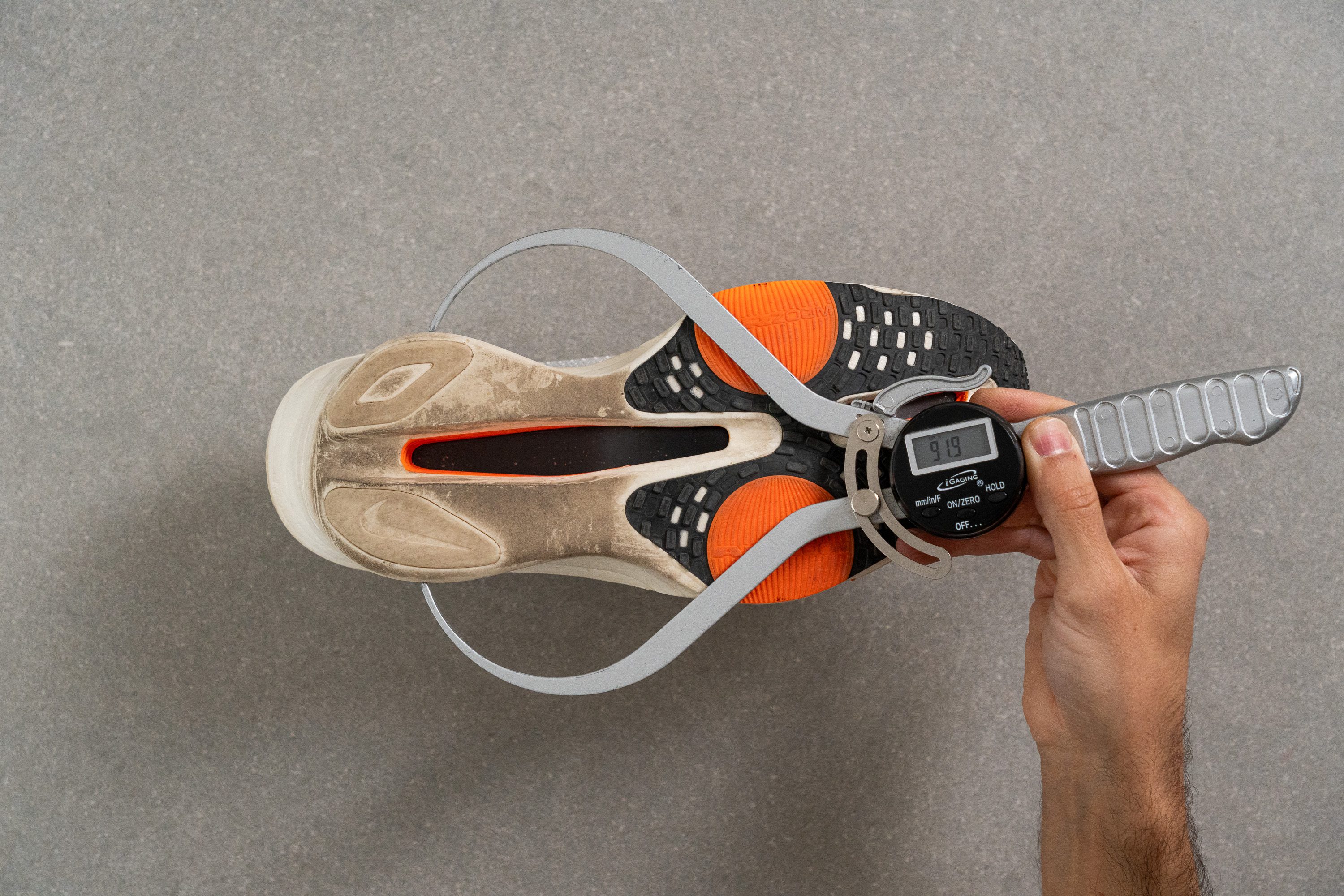
| Alphafly 3 | 91.9 mm |
| Average | 90.7 mm |
Durability
Toebox durability
Following the impressive breathability test, we moved on to durability assessments, where we encountered a significant setback compared to the Alphafly 2.
Our Dremel test on the toebox resulted in a large, round hole—the upper offered virtually no resistance, earning a disappointing 1/5 from us.
This starkly contrasts with the AF2, which had aced the test with a 5/5. If toebox durability is a priority for you, you might want to consider the previous model instead.

| Alphafly 3 | 1 |
| Average | 2.6 |
Heel padding durability
Luckily, the situation with the heel area is a complete turnaround. Nike went above and beyond to make the heel exceptionally padded, a feature that often results in quicker wear in the Achilles area.
Contrary to what one might expect, our tests showed a much more positive outcome. We conducted the same Dremel test as before—5 seconds at 3.2N and 5K RPM—and the results were outstanding! We were thrilled to give the Alphafly 3 a perfect score of 5/5.
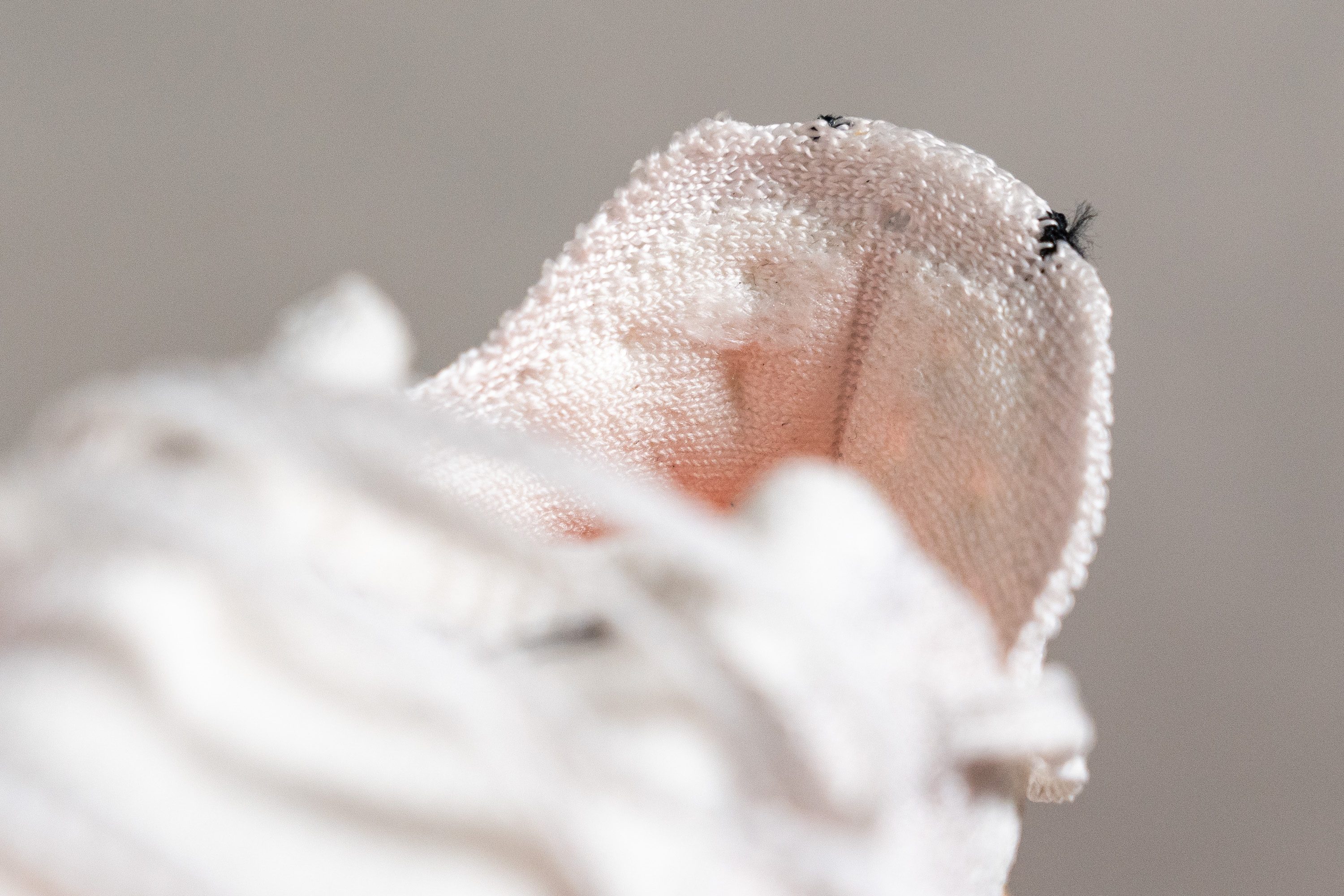
| Alphafly 3 | 5 |
| Average | 3.4 |
Outsole hardness
Nike has reinforced much of the midsole with the Fast Shot rubber, particularly in the forefoot area. However, there are exposed sections in the midfoot that may be more susceptible to wear and tear depending on your running form.

Interestingly, Nike opted for a unique rubber formulation for different parts of the shoe. The heel is a bit harder (82.8 HC), while the forefoot is softer (75.5 HC) to enhance traction.
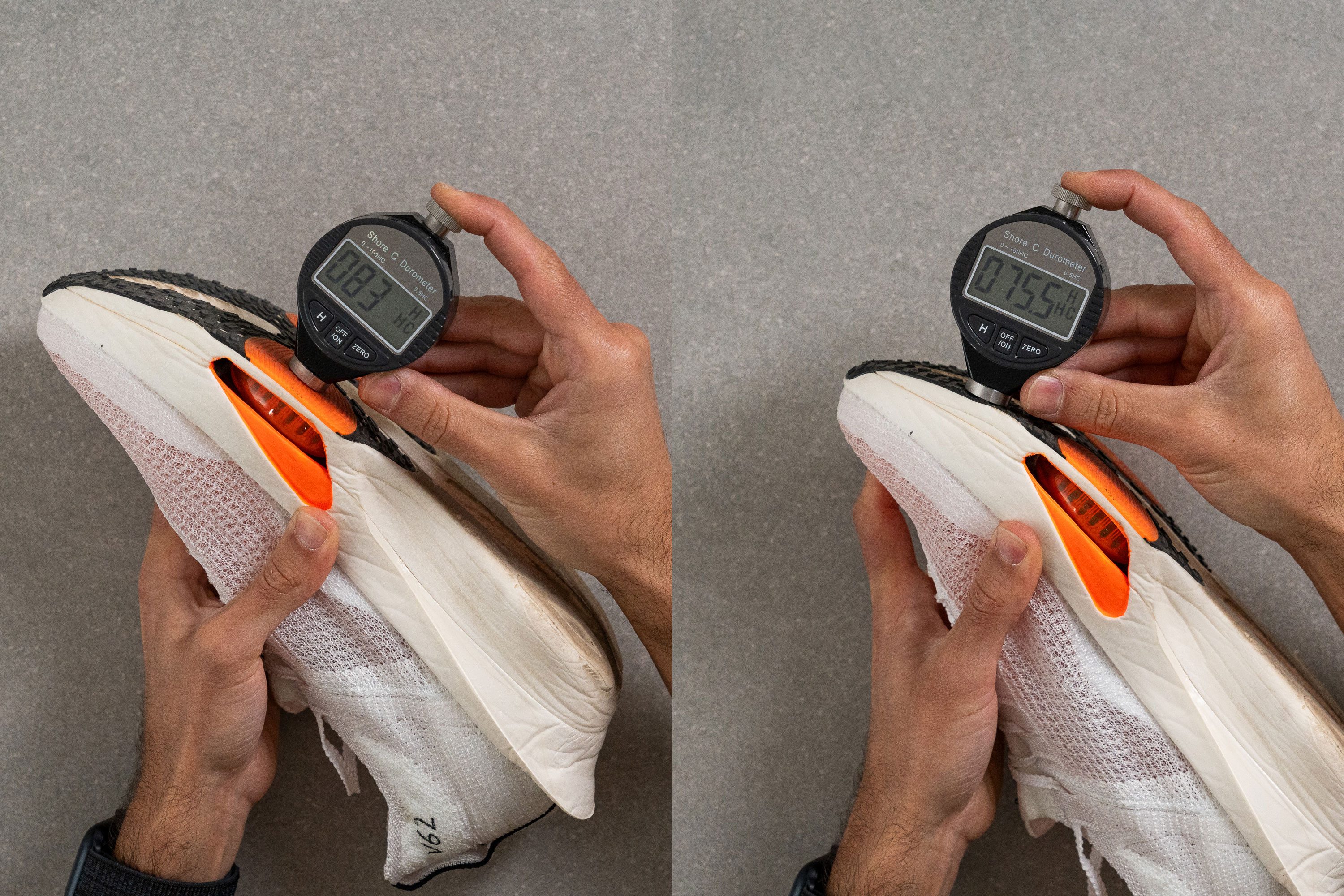
We also tested the orange rubber of the Air Pods, noticing it looked tougher than the rest. Our tests confirmed this with a reading of 83.0 HC.

| Alphafly 3 | 82.8 HC |
| Average | 79.2 HC |
Outsole durability
When it comes to outsole durability, racing shoes typically set the bar low. Yet, we couldn't help but hope for more from the Fast Shot outsole, given its durometer readings.
Disappointingly, we discovered a 3.2-mm indentation in the heel area, raising significant concerns for rearfoot strikers.
On a brighter note, midfoot and forefoot strikers might find the outsole way more enduring, thanks to better coverage and more evenly distributed forces in those areas. Indeed, we've seen two prototypes featuring the Fast Shot same outsole, with well over 300 miles—both belonging to forefoot or midfoot strikers—and they displayed impressive durability. So, as always, take the Dremel test with a grain of salt!
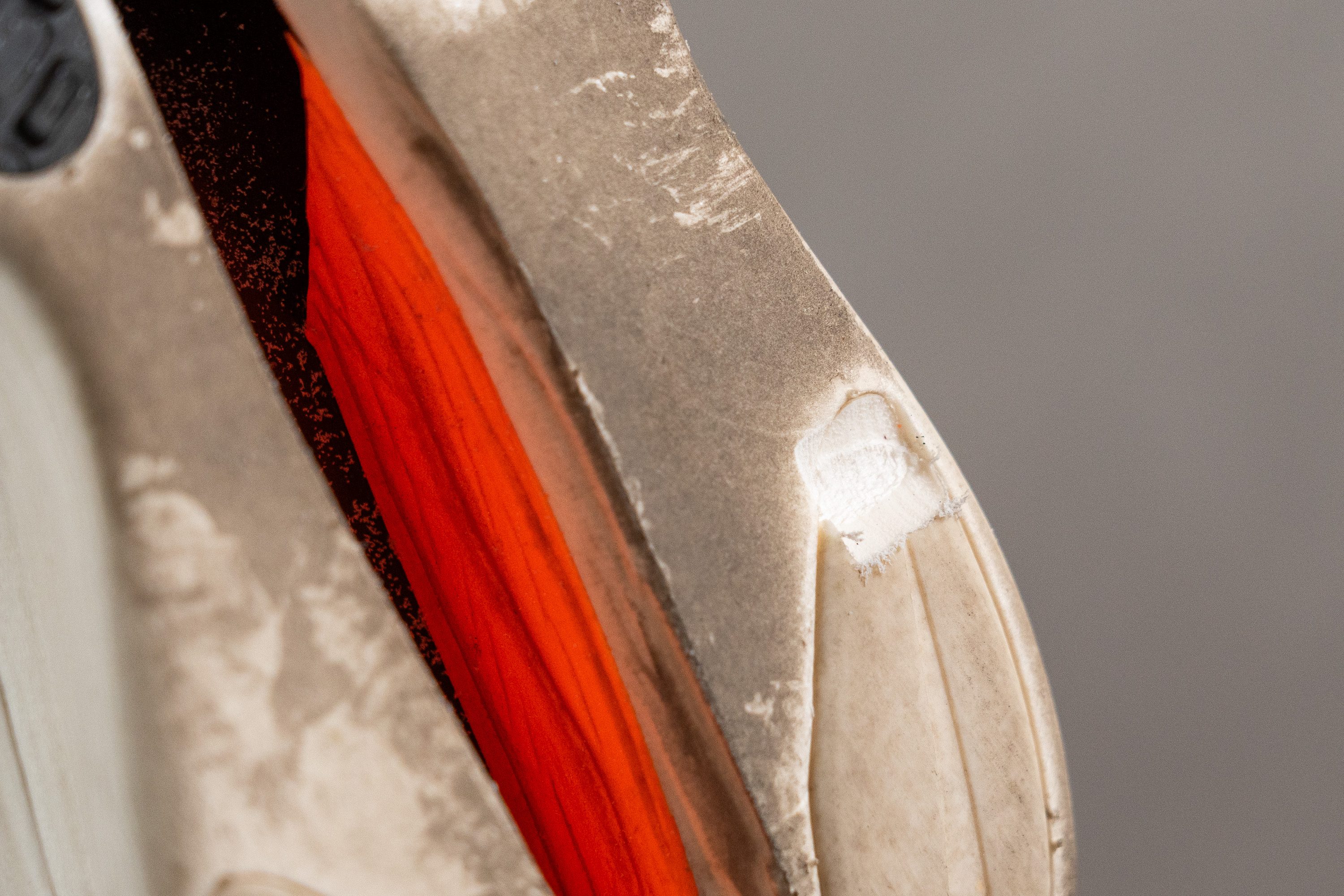
| Alphafly 3 | 3.2 mm |
| Average | 1.1 mm |
Outsole thickness
Regarding thickness, we believe Nike had no choice but to opt for a thin rubber despite using a less durable compound. The reason is straightforward—in a shoe designed to break world records, performance is key, and that depends on the midsole.

That's why we measured just 1.9 mm in the outsole thickness test. Frankly, we anticipate racing shoes might become even thinner in the future.
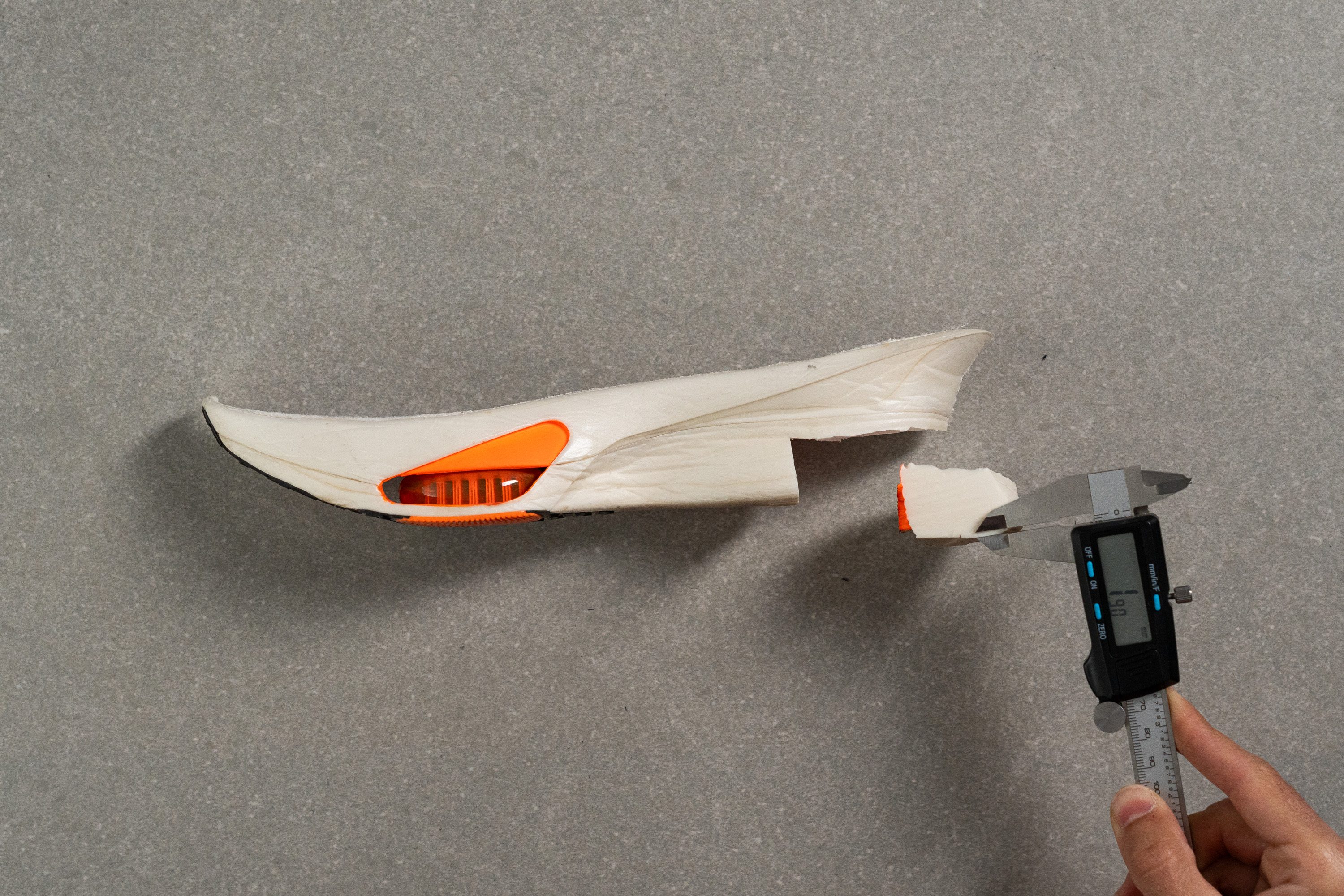
| Alphafly 3 | 1.9 mm |
| Average | 3.2 mm |
Misc
Insole thickness
In our lab tests, we discovered that the Alphafly 3's insole is remarkably thin at just 1.9 mm. But there's a good reason for this.
With World Athletics capping shoe stack heights at 40 mm, we think it's smart for brands like Nike to focus on maximising the midsole, which provides significantly more energy return than an insole, even if it means a bit less comfort.
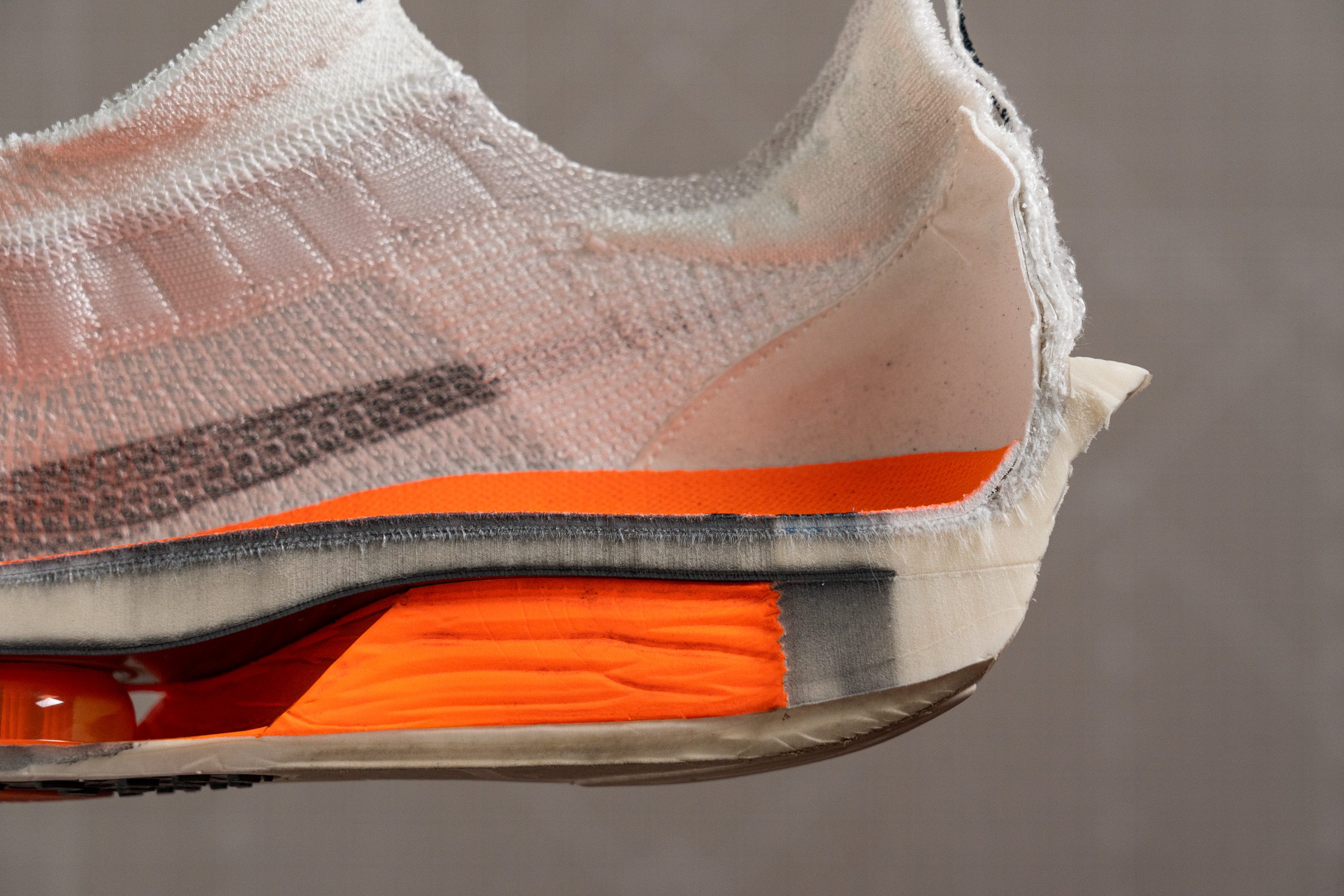
During all of our long runs, the insole never crossed our minds—not even once. There's no clearer indication that the 1.9 mm thickness is truly sufficient, at least for us.
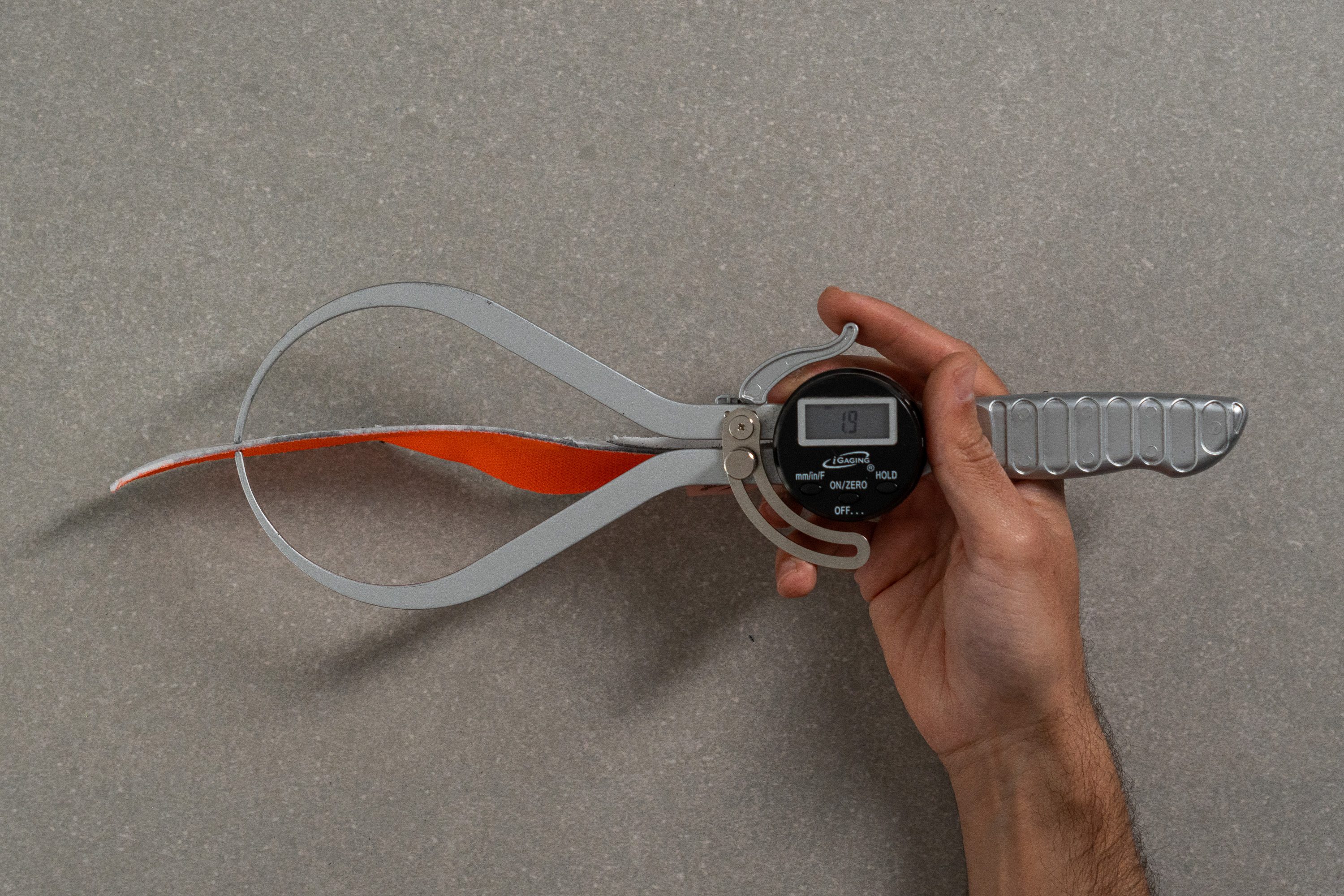
| Alphafly 3 | 1.9 mm |
| Average | 4.5 mm |
Removable insole
Like all Nike road racing shoes, the insole is glued down, making it really tough to remove.
But since the insole is very thin, you can place your orthotics on top of it. Many runners have done this with the Alphafly v1 and v2, adding their own insoles to avoid blisters on the arch.
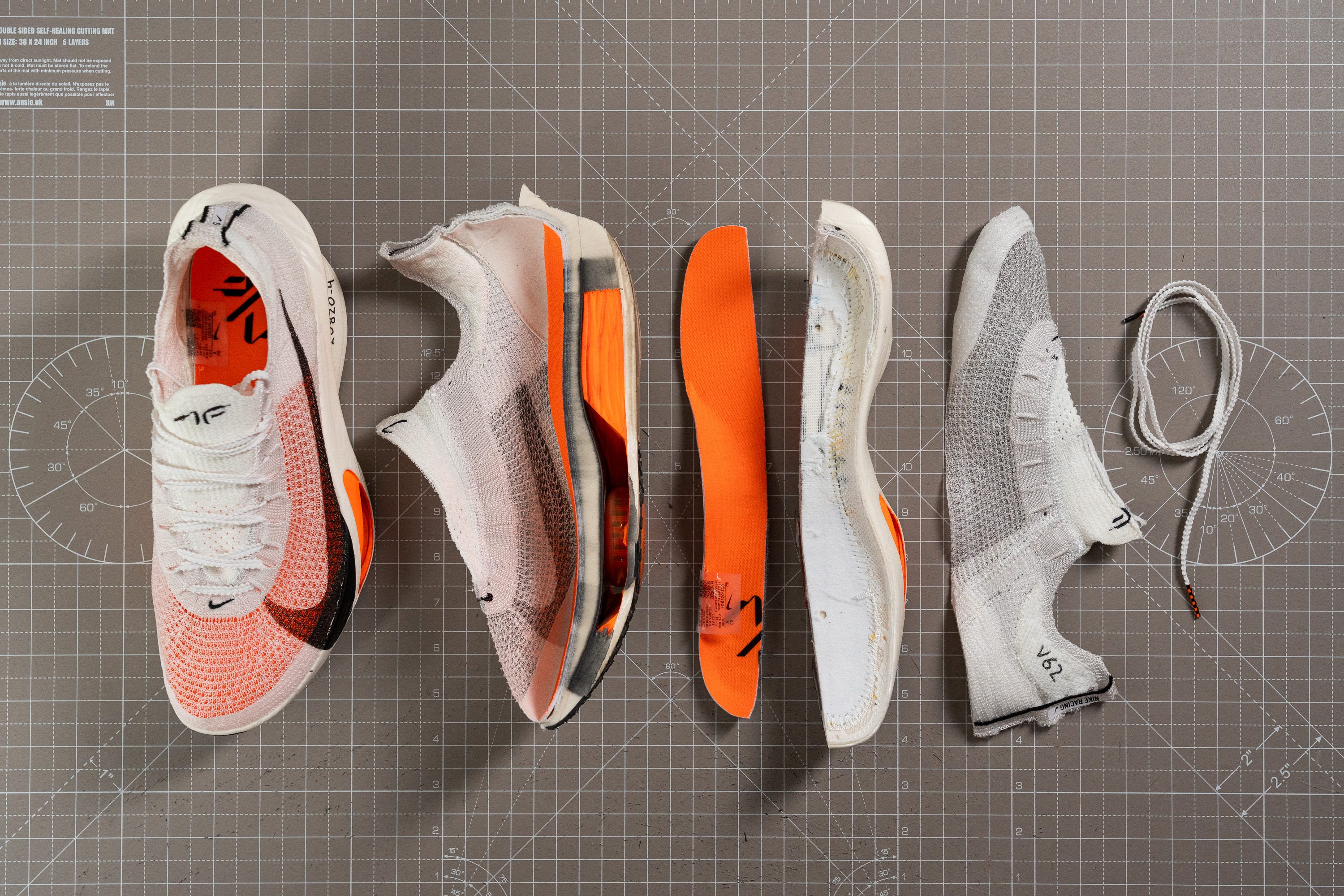
| Alphafly 3 | No |
Midsole softness in cold (%)
Given that some marathons take place in cold conditions, we feel that it's interesting to see how the AF3 performs in cooler temperatures. To test this, we placed the shoe in the freezer for 20 minutes before checking again the ZoomX foam.
We discovered that the midsole only became 17.2% firmer, a change that's barely perceptible. This is an impressive performance, aligning with our expectations, because Pebax-based foams like ZoomX are outstanding at maintaining their properties across a broad range of temperatures.
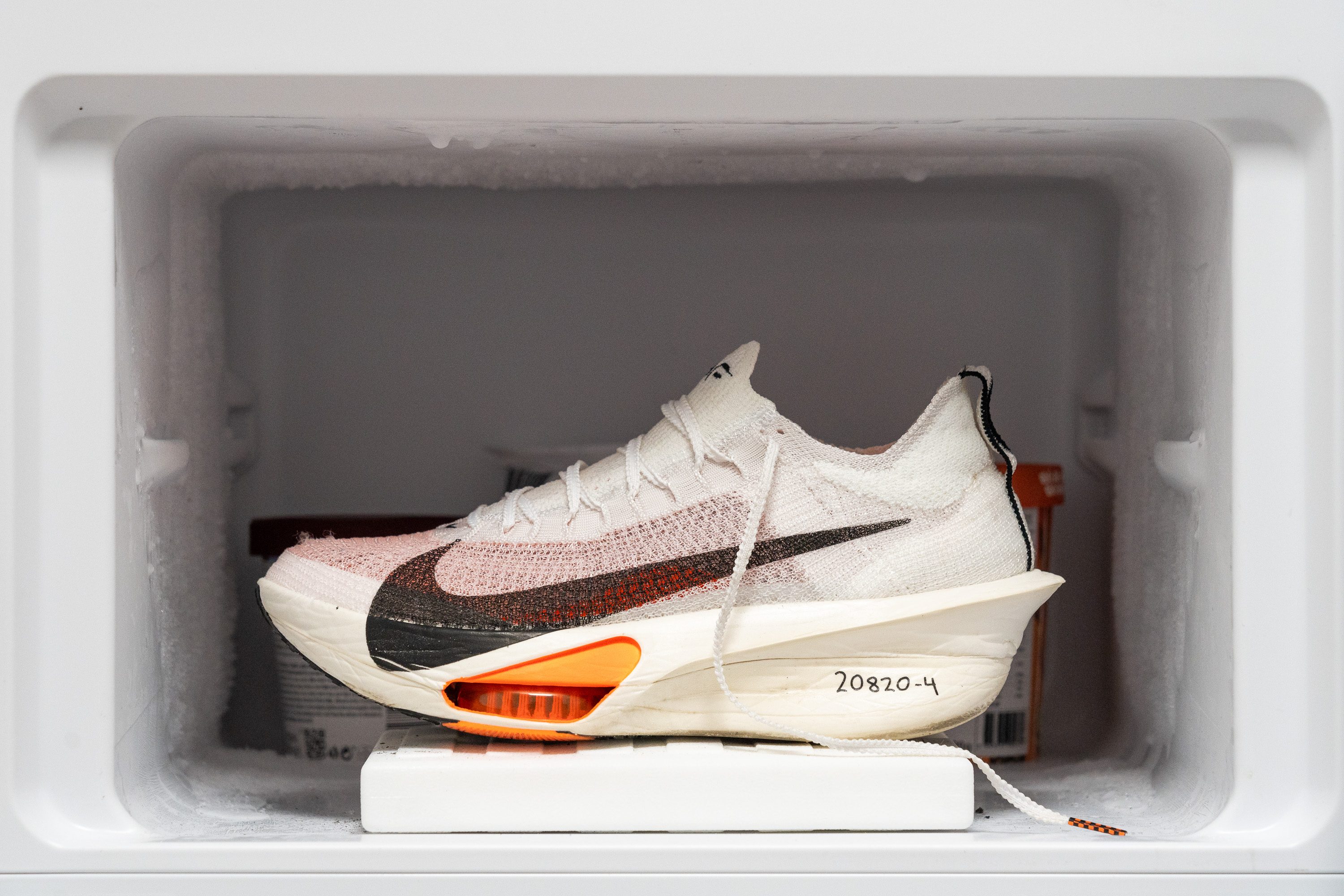
| Alphafly 3 | 17% |
| Average | 24% |
Reflective elements
We discovered that the Nike Alphafly 3 lacks reflective elements.
However, this is one of the few times we actually prefer it that way—it's another way to reduce some weight. After all, chances are extremely low that we're not running a night marathon on the road with lights shining on us.
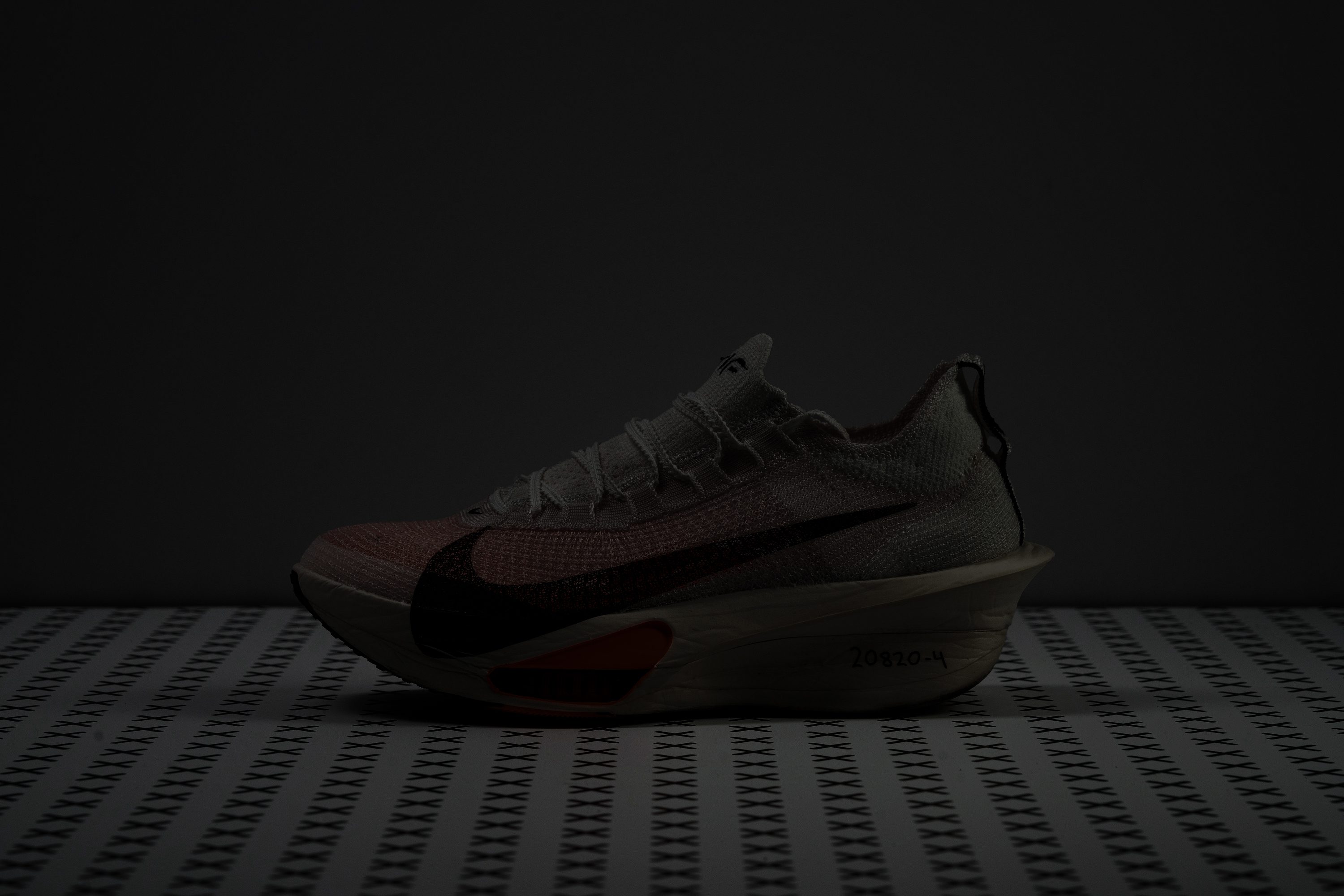
| Alphafly 3 | No |
Tongue padding
We noticed that Nike used less padding in the tongue—2.8 mm, down from 3.5 mm in the Alphafly 2.
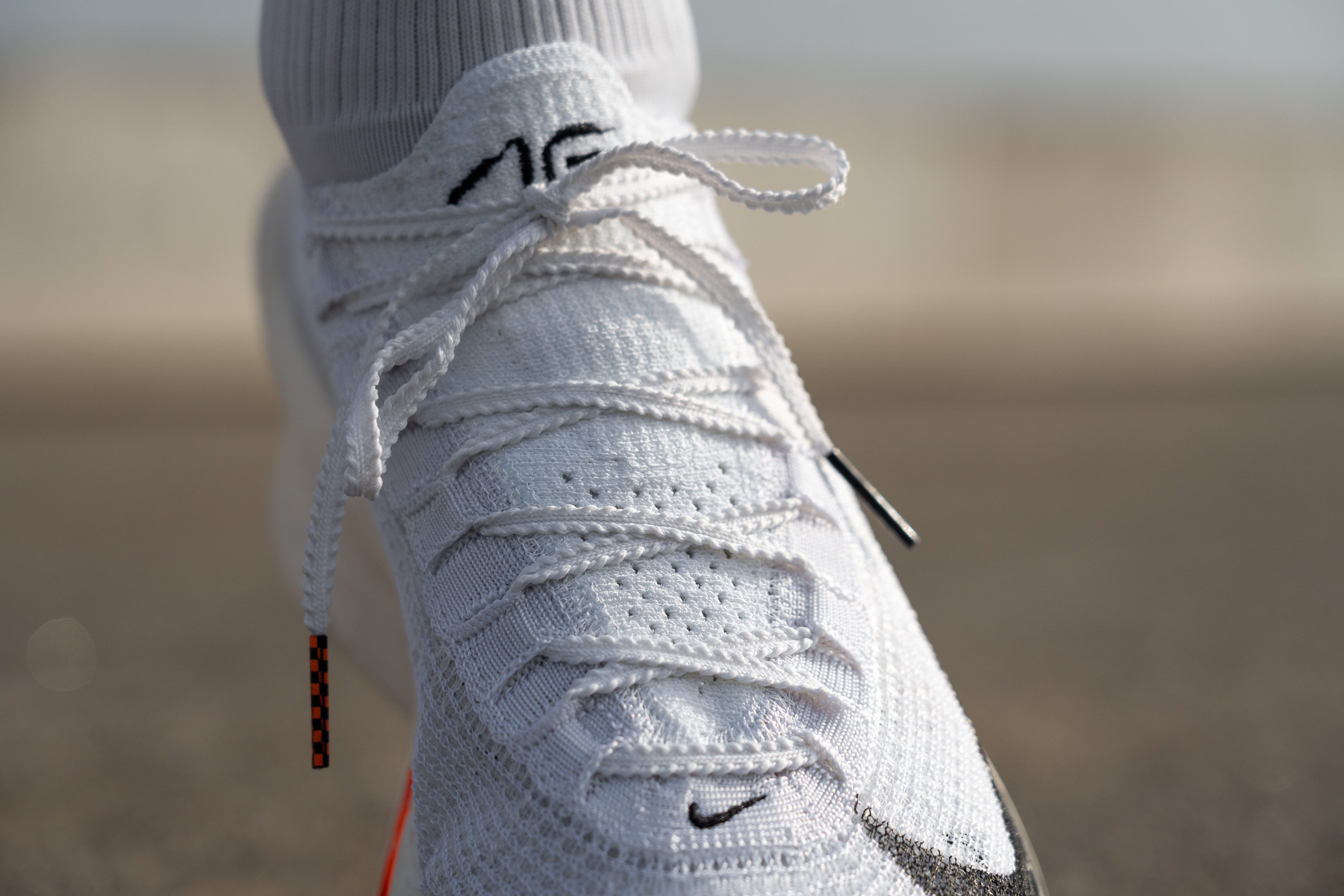
However, 2.8 mm is still on the thicker side compared to the world's best racing shoes, and we haven't felt any discomfort during our test runs or in races.
| Shoe | Tongue padding (mm) |
| Nike Vaporfly 3 | 2.5 |
| ASICS Metaspeed Sky+ | 0.8 |
| Adidas Adizero Adios Pro 3 | 0.9 |
| Saucony Endorphin Elite | 0.9 |
| Hoka Rocket X 2 | 1.9 |

| Alphafly 3 | 2.8 mm |
| Average | 5.8 mm |
Tongue: gusset type
The Atomknit upper's signature feature, the sock-like tongue, has both fans and critics since the v1.
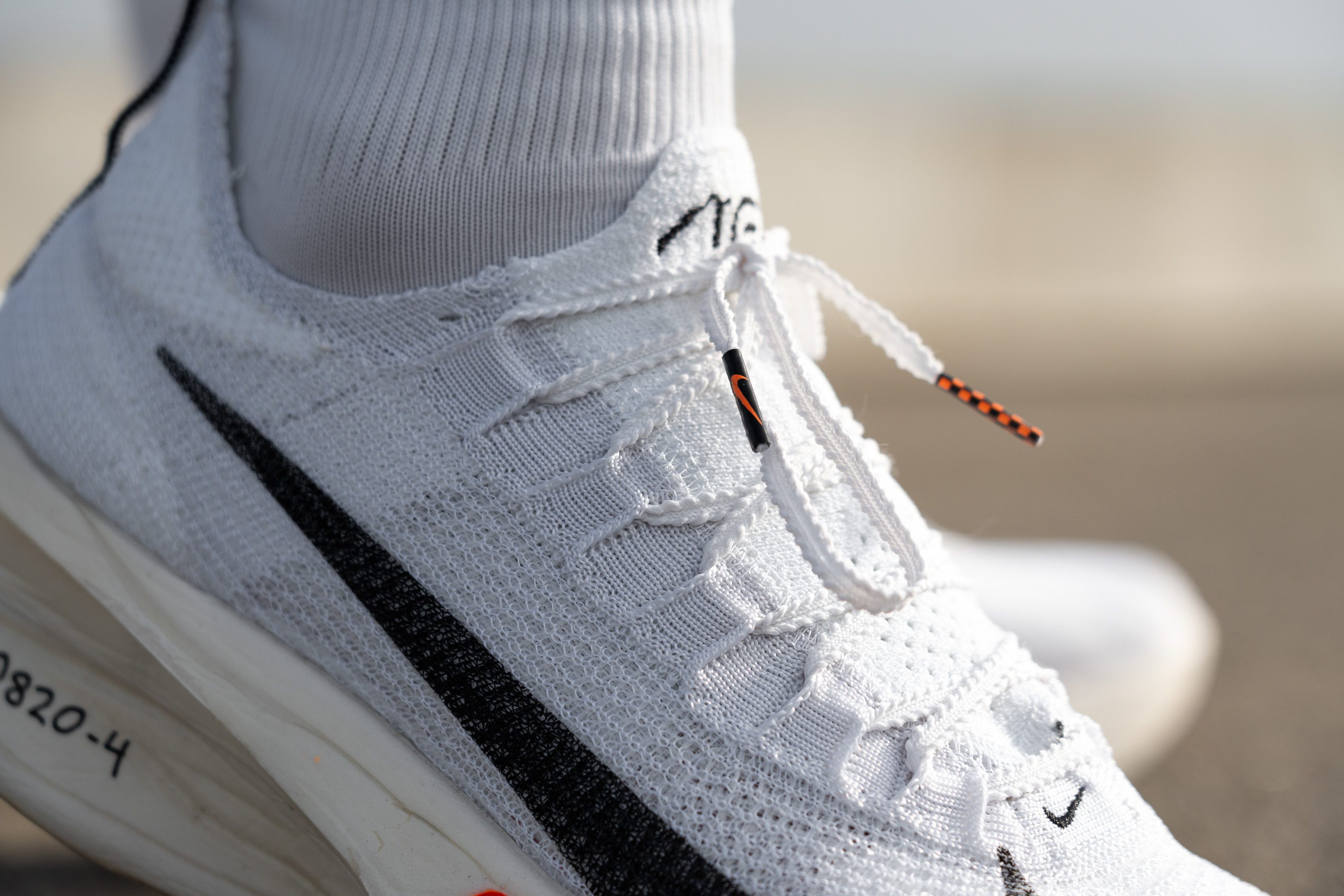
We were again impressed by it in the Alphafly 3 because it obviously eliminates any tongue shifting and guarantees an exceptional fit. On top of that, it's incredibly stretchy and comfortable—exactly what you'd expect in a premium, 285-bucks shoe.
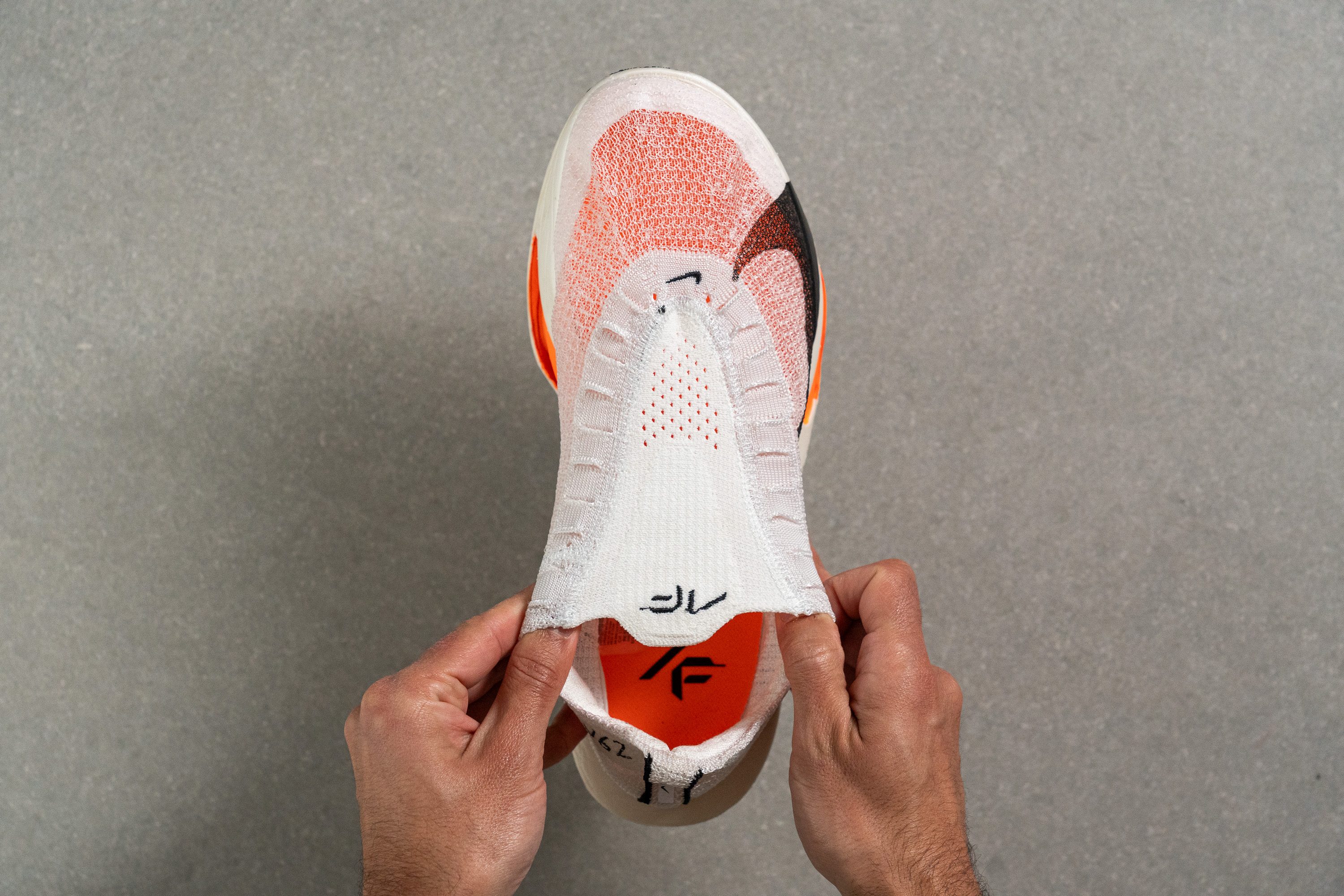
| Alphafly 3 | Sock like |
Heel tab
The Alphafly 3 no longer has the tongue tab, but it retains the iconic finger-loop on the heel, which is very handy for sliding your feet into the sock-like upper.
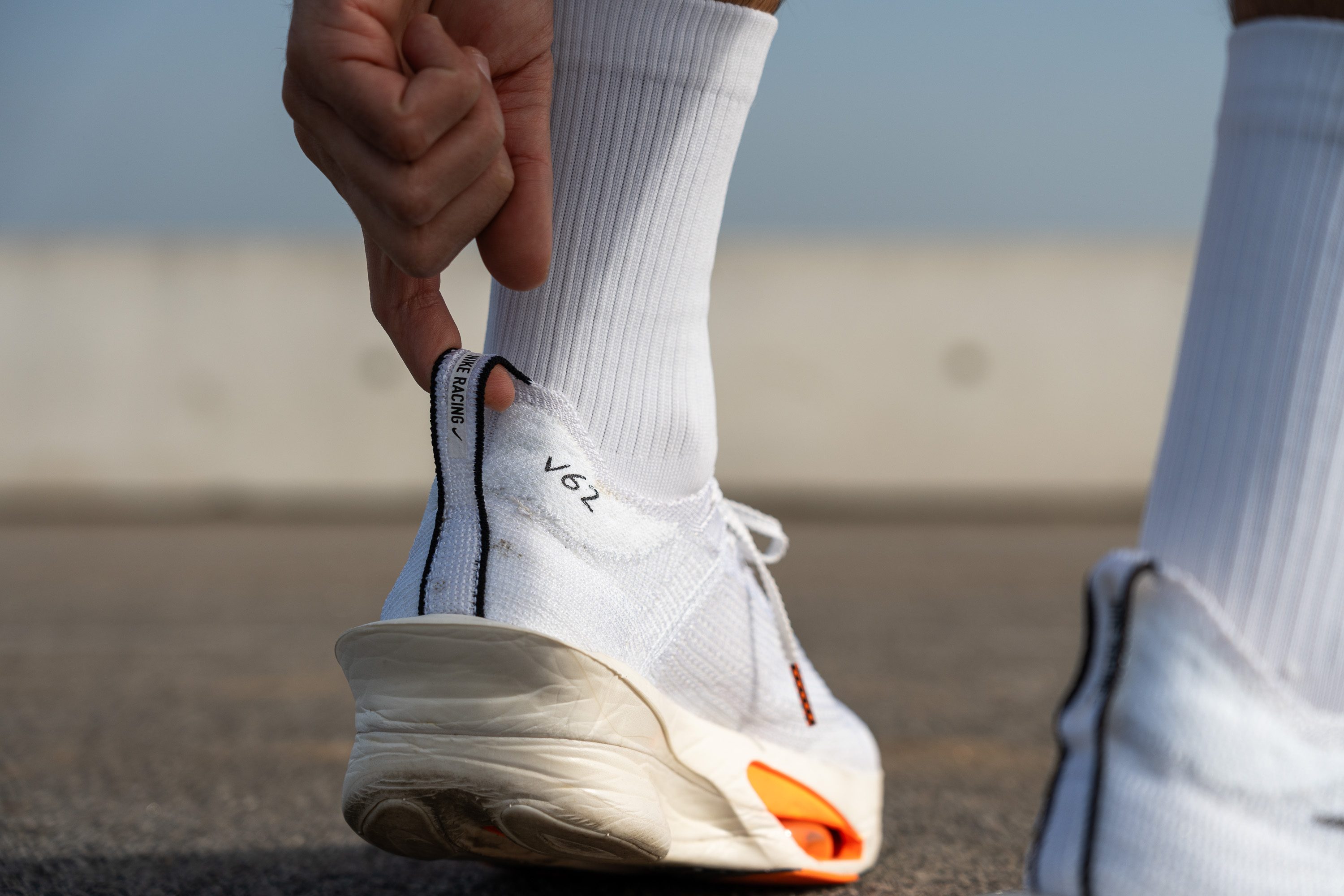
| Alphafly 3 | Finger loop |


















































































